Archived Water Damage Blog Posts
Water Damage - SERVPRO Can Help!
5/2/2024 (Permalink)
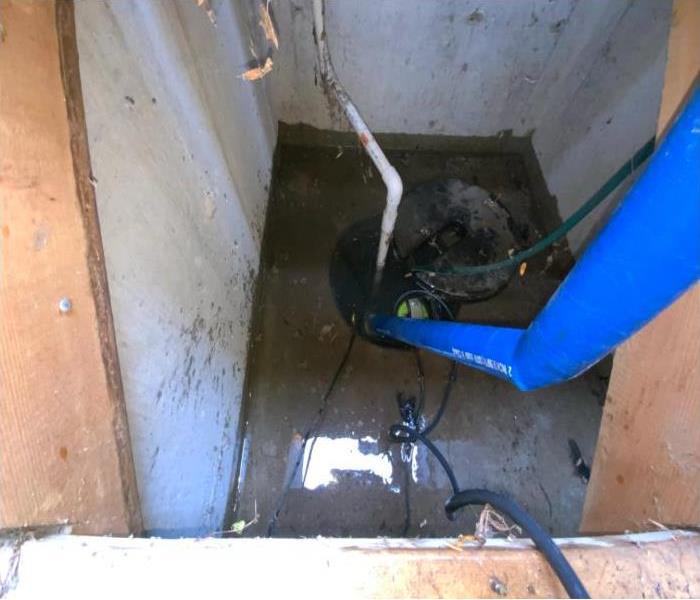 Faster to any size disaster
Faster to any size disaster
SERVPRO Water Cleanup Preserves Cambridge Homes
Moisture, regardless of the source, can put additional stress on homeowners. While minor damages may seem only to need a few fans to dry, this DIY solution might not prove sufficient for moisture inside walls or ceiling cavities. This unseen damage impacts framing, insulation, wiring, and even plumbing. Mold can start proliferating within just one to two days. Professional water restoration can save Cambridge residents time and money while keeping their belongings safer from damage, even for small disasters.
SERVPRO addresses water removal needs for Cambridge homeowners 24 hours a day with a suite of tools tailored to the job. This equipment, along with SERVPRO's repertoire of EPA-registered biocides, can eliminate water-related odors, microbes, and moisture.
How Long Does Water Damage Take to Dry?
The answer to this particular question depends on various factors, which can include:
- Ambient temperature and humidity levels
- The extent of impacted structures and contents
- The materials affected and their individual drying needs
- Whether the damage was sudden or gradual
- Whether mold is present
Professionals can resolve many clients' cleanup needs within hours of a property owner's call. Larger-scale disasters can take days to restore the property entirely. The most crucial part of this process is that homeowners act quickly after noticing water damage. The faster it is spotted after it occurs, the more efficiently technicians can clean it without additional concerns like extensive home repairs or mold remediation.
While DIY solutions can sometimes prove sufficient, this often does not guarantee that the disaster is fully addressed. Moisture can still exist inside wall cavities and other structural materials. On top of that, materials like wood, concrete, fabric, and drywall all require different types of care and react to moisture differently. Positioning several fans in a wet laundry room or kitchen, for example, may seem like enough to address the problem. However, it can unintentionally create secondary water damage without adequate dehumidification.
How SERVPRO Handles Water Cleanup, Drying, and Rebuilding
SERVPRO professionals can address moisture-related concerns with a meticulous inspection process, powerful extraction and drying tools, and sanitation solutions that can remediate odors and microbes.
- Before implementing a water damage plan, technicians inspect walls, flooring, carpet, and contents to determine moisture levels with pin-type and pinless moisture meters. Infrared cameras can determine the presence of moisture inside ceilings, walls, or floors. At the same time, thermohydrometers help technicians establish current relative humidity compared to a clean, dry area of the home if possible.
- After formulating a plan of action and clearing it with homeowners, technicians can focus on extracting excess moisture, typically performed with extraction units. While there is rarely standing water present after damage occurs, SERVPRO can address it when present with the vacuum component of an extractor. Submersible sump pumps can remove water two inches or deeper. Extraction may take several passes to reach adequate moisture levels to begin drying but makes the overall process hundreds of times faster.
- Technicians position air movement equipment for maximum water mitigation, pulling residual moisture off surfaces for refrigerant coil dehumidification units to collect. Heavily impacted structural materials with minimal other objects present may require high-powered desiccant dehumidifiers.
We're Faster To Any Size Disaster and can implement restoration tools when homeowners need them most. Call SERVPRO of Cambridge / Belmont at (617) 864-7378 for responsive restoration and build-back services.
The Factors That Impact Water Damage Drying
4/13/2023 (Permalink)
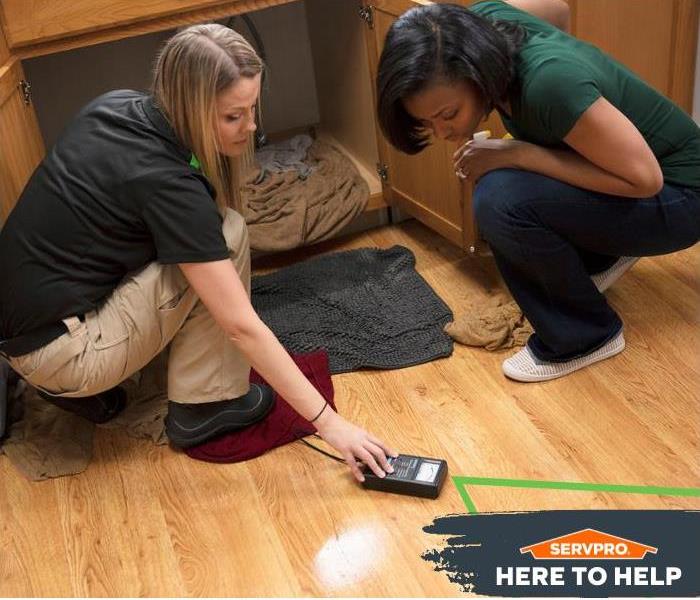 A water leak can escalate into a bigger problem. Contact the SERVPRO team in Cambridge if you are dealing with any water damage.
A water leak can escalate into a bigger problem. Contact the SERVPRO team in Cambridge if you are dealing with any water damage.
SERVPRO Water Cleanup Preserves Cambridge Homes
Moisture, regardless of the source, can put additional stress on homeowners. While minor damages may seem only to need a few fans to dry, this DIY solution might not prove sufficient for moisture inside walls or ceiling cavities. This unseen damage impacts framing, insulation, wiring, and even plumbing. Mold can start proliferating within just one to two days. Professional water restoration can save Cambridge residents time and money while keeping their belongings safer from damage, even for small disasters.
SERVPRO addresses water removal needs for Cambridge homeowners 24 hours a day with a suite of tools tailored to the job. This equipment, along with SERVPRO's repertoire of EPA-registered biocides, can eliminate water-related odors, microbes, and moisture.
How Long Does Water Damage Take to Dry?
The answer to this particular question depends on various factors, which can include:
- Ambient temperature and humidity levels
- The extent of impacted structures and contents
- The materials affected and their individual drying needs
- Whether the damage was sudden or gradual
- Whether mold is present
Professionals can resolve many clients' cleanup needs within hours of a property owner's call. Larger-scale disasters can take days to restore the property entirely. The most crucial part of this process is that homeowners act quickly after noticing water damage. The faster it is spotted after it occurs, the more efficiently technicians can clean it without additional concerns like extensive home repairs or mold remediation.
While DIY solutions can sometimes prove sufficient, this often does not guarantee that the disaster is fully addressed. Moisture can still exist inside wall cavities and other structural materials. On top of that, materials like wood, concrete, fabric, and drywall all require different types of care and react to moisture differently. Positioning several fans in a wet laundry room or kitchen, for example, may seem like enough to address the problem. However, it can unintentionally create secondary water damage without adequate dehumidification.
How SERVPRO Handles Water Cleanup, Drying, and Rebuilding
SERVPRO professionals can address moisture-related concerns with a meticulous inspection process, powerful extraction and drying tools, and sanitation solutions that can remediate odors and microbes.
- Before implementing a water damage plan, technicians inspect walls, flooring, carpet, and contents to determine moisture levels with pin-type and pinless moisture meters. Infrared cameras can determine the presence of moisture inside ceilings, walls, or floors. At the same time, thermohygrometers help technicians establish current relative humidity compared to a clean, dry area of the home if possible.
- After formulating a plan of action and clearing it with homeowners, technicians can focus on extracting excess moisture, typically performed with extraction units. While there is rarely standing water present after damage occurs, SERVPRO can address it when present with the vacuum component of an extractor. Submersible sump pumps can remove water two inches or deeper. Extraction may take several passes to reach adequate moisture levels to begin drying but makes the overall process hundreds of times faster.
- Technicians position air movement equipment for maximum water mitigation, pulling residual moisture off surfaces for refrigerant coil dehumidification units to collect. Heavily impacted structural materials with minimal other objects present may require high-powered desiccant dehumidifiers.
We're Faster To Any Size Disaster and can implement restoration tools when homeowners need them most. Call SERVPRO of Cambridge / Belmont at (617) 864-7378 for responsive restoration and build-back services.
Benefits of Drying Your Cambridge Property After a Water Damage Scare
2/8/2023 (Permalink)
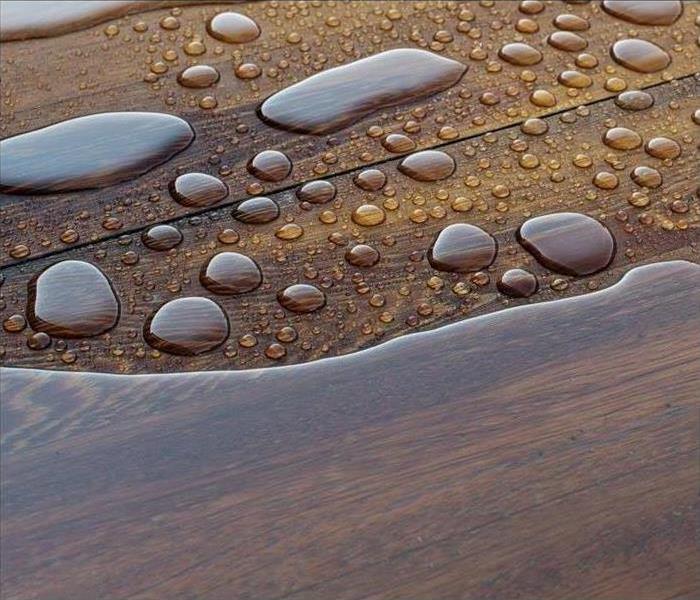 Contact SERVPRO to effectively tackle the water damage in your property. Call now!
Contact SERVPRO to effectively tackle the water damage in your property. Call now!
SERVPRO Professionally Dries Your Water-Damaged Cambridge Home
There are several techniques that water damage restoration technicians use to restore homes after such stressful events. We use specialized equipment such as hand-held extractors, wet-dry vacuums, and submersible pumps to remove as much water as possible from the building. Though all may seem well at this point, we still need to dry your home to the required moisture levels.
Our SERVPRO technicians use a combination of techniques when drying water-damaged properties in Cambridge. Some specialized equipment that we use to remove the remaining moisture and speed up drying include heaters, dehumidifiers, and air movers. We use the following equipment to check moisture levels during drying:
- Moisture Meters: They are usually available in two types: the non-invasive and pin-type. They have probes that help measure moisture content in materials such as concrete, wood, and drywall.
- Thermal Imaging Cameras: Once they detect temperature differences through infrared technology, it shows moisture exists in the area. They are suitable for detecting hidden moisture existing under floors and behind walls.
- Hygrometers: We use these devices to measure both temperature and relative humidity – the two are useful indicators when needed to determine the amount of moisture in the air. They are useful when monitoring the drying process.
- Data Loggers: We use them when it is necessary to record and store humidity and temperature levels over a long time. They also enable our SERVPRO technicians to monitor the drying process and make adjustments where necessary.
Ensuring the structure and its materials achieve the appropriate moisture levels is important for the safety and health of the occupants and helps retain the property's market value and structural integrity. It explains why our technicians put in a lot of effort to ensure everything is done right.
Don't hesitate to call SERVPRO of Cambridge/Belmont at (617) 864-7378 whenever you face fire, water, or mold damage. We are industry restoration leaders who address issues quickly and efficiently to make it "Like it never even happened."
SERVPRO Handles all Water Damage Restoration in Cambridge
8/11/2022 (Permalink)
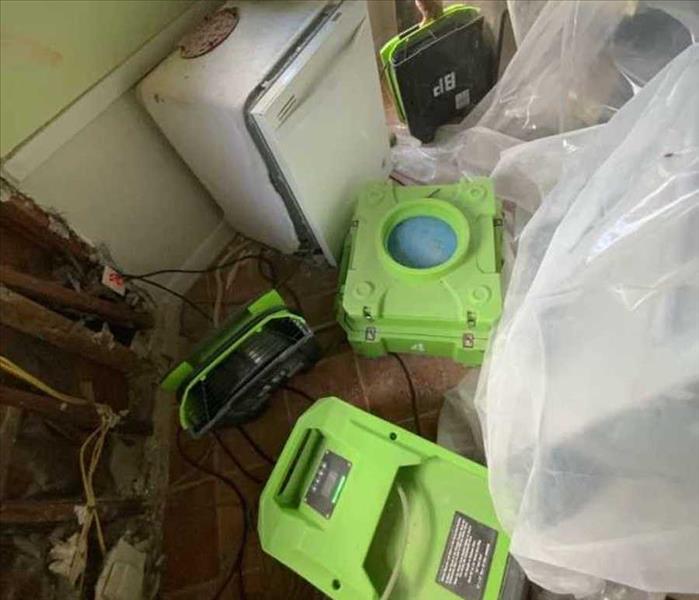 Water damage restoration is no DIY project. Let SERVPRO technicians handle al the work for you, from start to finish.
Water damage restoration is no DIY project. Let SERVPRO technicians handle al the work for you, from start to finish.
Rapid Water Removal in Cambridge Halts Deterioration
Any property disaster, including water intrusion events, worsens the longer you hesitate to act. It can be overwhelming to address such a disaster, which could lead to delays in taking action. Making plans ahead of time for an emergency can help you see your Cambridge property restored speedily after water damage occurs.
A complete Cambridge water damage restoration process has many steps. It considers all the small, essential details that otherwise could remain unnoticed, causing further and severe problems in the future. Water can get into seemingly unusual places. Therefore, restoration by experts involves cleaning and deodorizing such areas. Sanitation and odor removal are also part of the process. SERVPRO is quick to implement these steps to lessen the potential long-term damage. Our professionals are compassionate and want to help you get back to normal as quickly as possible.
Excess moisture causes issues such as:
- Microbial growth
- Damage to content
- Poor indoor air quality
The need for swift action is because standing water becomes more contaminated if not treated and removed, thus creating a perfect condition for microbial growth and damage to contents. Without proper water extraction, decontamination and drying, many long-term effects can take hold in a home. SERVPRO technicians specialize in restoring and repairing water damage using advanced equipment that, among other things, helps extract standing water and detect hidden moisture.
Factors determining restoration
The restoration resources required usually depend on various things, ranging from simple vacuuming and drying to complete reconstruction projects. Submersible pumps, truck-mounted vacuums, and portable wet/dry vacuums effectively extract water.
SERVPRO performs additional inspections to determine the remaining moisture levels and identify whether the floors and carpeting need to be removed.
Considerations during restoration
- The class and category of water destruction
- Exposure time
- The permeability level of materials affected
SERVPRO of Cambridge / Belmont IICRC has certified experts that provide thorough and effective water recovery services. They follow the best industry practices of keeping up-to-date on the latest cleanup techniques. You can reach us at (617) 864-7378. We're Faster To Any Size Disaster.
Need Water Damage Cleanup in Cambridge – Call SERVPRO
7/11/2022 (Permalink)
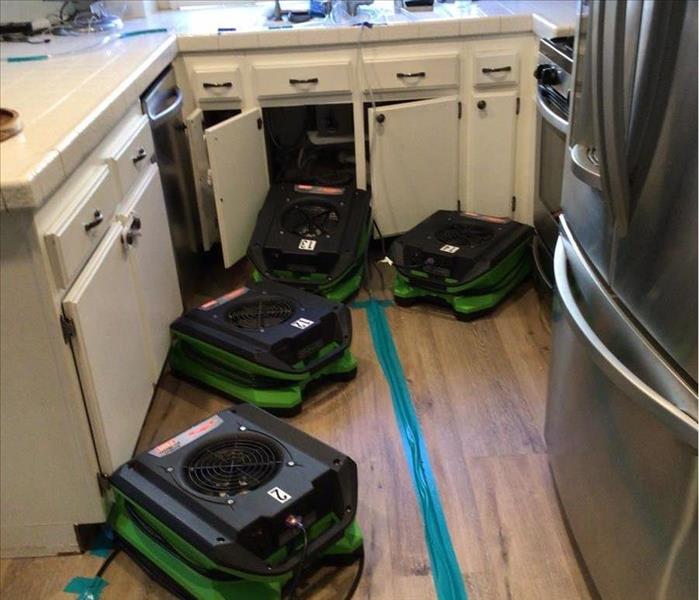 All you need is SERVPRO for all your water damage needs. Call (617) 864-7378.
All you need is SERVPRO for all your water damage needs. Call (617) 864-7378.
SERVPRO Provides Water Damage Cleanup and Drying in Cambridge
Many homeowners in Cambridge attempt to clean up their homes on their own after a water leak or perhaps an overflowing sink or tub. They mop up all the excess water and hope that not too much water has seeped under the cabinets or into the floor and subfloor. Only a few days later, they notice hardwood floors or subfloors are swelling, causing cupping, buckling, or warping. They may even notice a musty odor around carpeted floors or under cabinets, a sign of mold.
SERVPRO provides water damage cleanup to residents of Cambridge and the surrounding area. We encourage residents to mop up as much water as possible after correcting the water source. We can be onsite in less than four hours from your call and immediately take action to remove additional moisture from beneath floors and cabinets before further damage occurs.
We apply weighted water removers to carpets, floor drying mats to hardwood floors, and use vacuum wands to remove water and moisture from under cabinets or inside walls. Removing water and moisture from these difficult-to-reach areas reduces the amount of moisture available to be absorbed by these structures.
We deploy high-capacity air movers and dehumidifiers to reduce humidity levels further and draw out any remaining moisture in carpets, floors, cabinets, and walls. Wet moves to dry, and your feet, etc., will be completely dry within a few days with no further damage or concern about mold colonies growing in your home.
SERVPRO provides the following services to their clients:
- Water damage cleanup and repairs
- Ceiling repairs from water damages
- Emergency services water damage restoration
Call SERVPRO of Cambridge / Belmont for water damage restoration services. We cover Cambridge and nearby areas. We can help 24/7. Call (617) 864-7378.
Restoring Belmont Residential Carpet After Water Damage
5/29/2022 (Permalink)
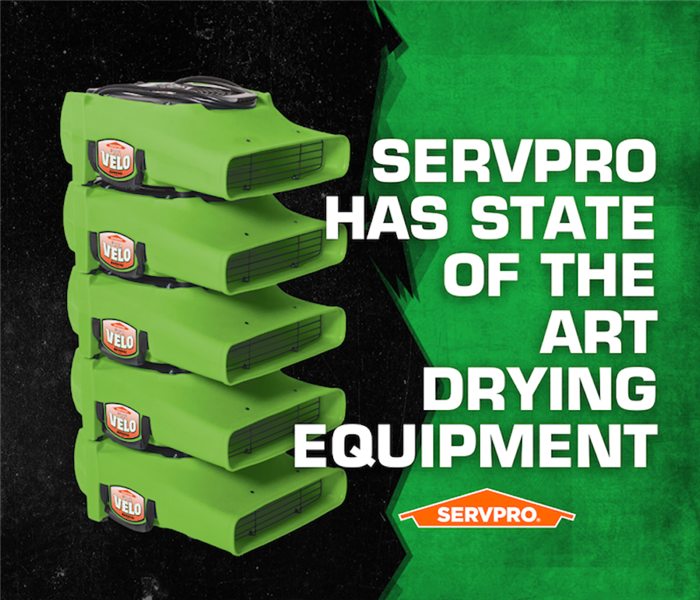 SERVPRO techs use the latest technology and equipment for every water damage restoration project. Call now!
SERVPRO techs use the latest technology and equipment for every water damage restoration project. Call now!
Belmont Carpet Cleanup Performed by SERVPRO
Home carpeting is one of the most vulnerable surfaces in a given home. While Cambridge homeowners can use consumer-grade vacuums with carpet cleaning and extraction features to mitigate damage, these solutions do not guarantee complete water removal. These tools can also unintentionally cause damage like delamination, where the backing separates from the fibers.
Water damage restoration from Belmont SERVPRO professionals can ensure that home flooring, baseboards, and more are returned to a pre-disaster condition. Carpet restoration includes cleaning, drying, re-seaming, and repairs to ensure that the home is clean, dry, and comfortable for occupants.
SERVPRO's Carpet Cleanup and Drying Process
Carpet requires a certain degree of care and knowledge about residential carpeting construction. For example, a typical carpet features two backings: a primary one to hold the fibers and a second underneath. The two layers are often held together by a latex adhesive.
SERVPRO techs can combat wet carpets with a diverse array of processes:
- Making multiple passes over the wet carpet with a carpet wand attached to a hot water extractor. The extraction process requires extra care and attention to prevent damage to fibers, adhesives, or backing
- Carpet can be partially pulled up to inspect subflooring or to tent the carpet so that air movers and dehumidifiers can dry above and below the surface
- Deodorization methods include injection for spot cleanup, ultra-low volume fogging for larger-scale odor control, and application of EPA-registered biocides
Carpet and pad are typically salvageable after clean water damage like pipe leaks or appliance overflows. However, SERVPRO can implement repairs and reinstall the carpet as necessary.
Homeowners can look to SERVPRO of Cambridge / Belmont for cleanup that can make a disaster seem "Like it never even happened." Call (617) 864-7378 for mitigation from an emergency-response restoration crew.
Water Damage - We are here to help!
3/24/2022 (Permalink)
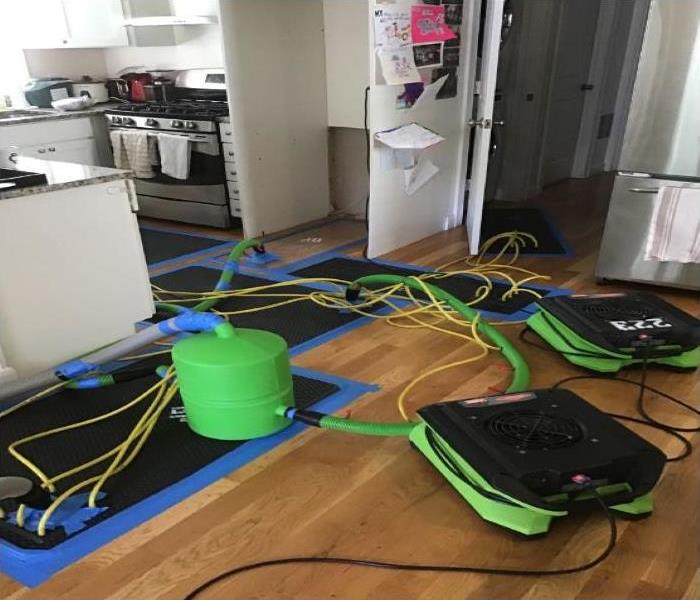 If you sustain water damage, please call SERVPRO of Cambridge/Belmont (617) 864-7378 to assist you.
If you sustain water damage, please call SERVPRO of Cambridge/Belmont (617) 864-7378 to assist you.
John & Sue Butler’s contractor had finally finished the renovations. They had been living with relatives until their new condominium was finished. The furniture and belongings were delivered and they were finally living in their dream home. They came home Sunday night after a weekend away and they noticed water dripping down from the ceiling. Their hardwood floors had standing water and were beginning to buckle. They discovered that their upstairs neighbor pipe broke causing the water to run down into their unit. They called SERVPRO of Cambridge/Belmont to assist them. The Butler’s explained that they had just moved in and didn’t want the life to be disrupted. The SERVPRO technician assessed the damages and came up with a plan that would not require any demolition. He discovered there were existing cavities he could install an Inject-I-Dry System that would dry out the floors & ceilings without any demolition or sanding. The technician monitored the drying progress and after one week, he determined that the floor and ceiling were dry and removed the equipment. The Butler’s were ecstatic!
Checking For Water Damage In Your Home
3/24/2022 (Permalink)
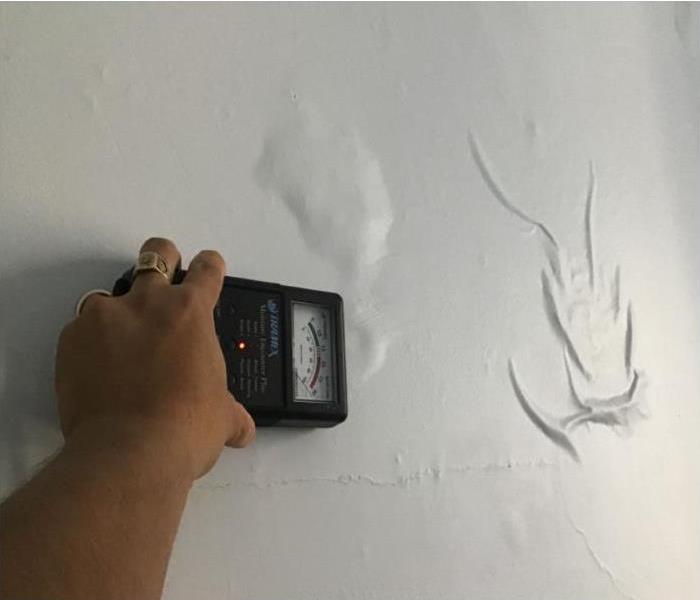 Get in touch today to speak with a water damage restoration expert. 617-864-7378
Get in touch today to speak with a water damage restoration expert. 617-864-7378
When it comes to keeping your home structurally sound and well-maintained, watching out for water damage is one of the best things you can do. Not only can water damage cause cosmetic problems and lead to unsightly spots throughout the home, but it can also significantly damage structures when it is allowed to fester.
Fortunately, homeowners can easily perform their own routine checks to look for water damage throughout the house, which can help them catch issues early and avoid having to make costly claims on their homeowners insurance.
Tips for Doing an At-Home Water Damage Inspection
Inspect your walls and ceilings. Drywall and paint can quickly show water damage, making walls and ceilings one of the best and easiest places to begin your search. Any discoloration, particularly soft spots or peeling areas of paint, might indicate that there is water damage present. It is also wise to check up on your external window and door frames for weather-related leakage.
Don’t forget to look down. It is not uncommon to find water damage that shows itself in the floor, since that is the lowest spot in every room. Water can pool and begin to saturate the subfloor, not causing surface issues but instead showing up with warped floorboards, buckling or a general smell of mildew, which should always be checked out.
Inspect your roof. It is important to keep your roof in good shape to make sure it is keeping out all the elements it can when it rains. A pair of binoculars can give you valuable insights into the quality of your roof and help you spot any loose shingles or peeling places. Additionally, it is smart to check that your gutters are doing their job the next time it rains to prevent water from building up around your foundation.
Pay close attention to the basement. Though basements have a reputation for being damp, if you have moisture problems under your home it can be a serious issue. Look for signs of water running down foundation walls or musty odors, which might indicate there is too much moisture present that should be addressed.
If you have water damage anywhere in your home, we are here to help. You can contact us at any hour to learn more about our services or to report damages.
Water Damage - We are here to help!
3/17/2022 (Permalink)
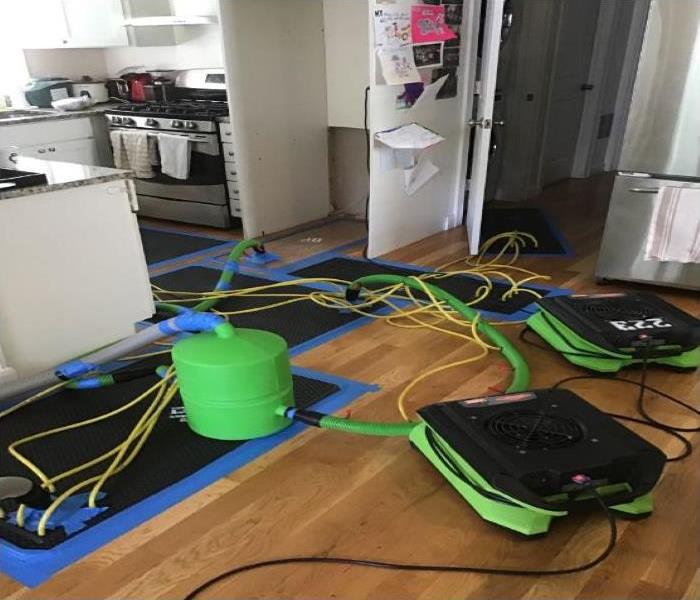 If you sustain water damage, please call SERVPRO of Cambridge/Belmont (617) 864-7378 to assist you.
If you sustain water damage, please call SERVPRO of Cambridge/Belmont (617) 864-7378 to assist you.
John & Sue Butler’s contractor had finally finished the renovations. They had been living with relatives until their new condominium was finished. The furniture and belongings were delivered and they were finally living in their dream home. They came home Sunday night after a weekend away and they noticed water dripping down from the ceiling. Their hardwood floors had standing water and were beginning to buckle. They discovered that their upstairs neighbor pipe broke causing the water to run down into their unit. They called SERVPRO of Cambridge/Belmont to assist them. The Butler’s explained that they had just moved in and didn’t want the life to be disrupted. The SERVPRO technician assessed the damages and came up with a plan that would not require any demolition. He discovered there were existing cavities he could install an Inject-I-Dry System that would dry out the floors & ceilings without any demolition or sanding. The technician monitored the drying progress and after one week, he determined that the floor and ceiling were dry and removed the equipment. The Butler’s were ecstatic!
What Happens Next After Water Damage | SERVPRO® of Cambridge/Belmont
2/14/2022 (Permalink)
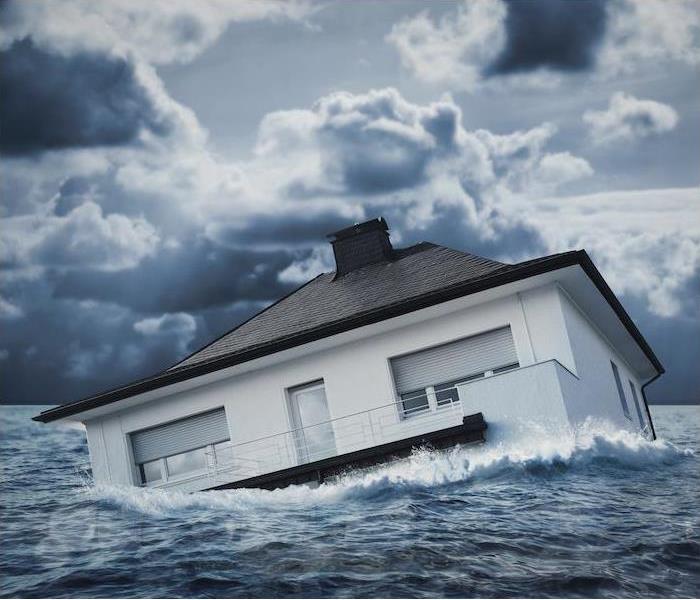 When water damage strikes, make the call to SERVPRO of Cambridge/Belmont for A-to-Z cleanup and restoration.
When water damage strikes, make the call to SERVPRO of Cambridge/Belmont for A-to-Z cleanup and restoration.
Each day, there are 14,000 Americans who have the unfortunate experience of water damage. That’s a lot of people in a day’s time, but when you have people like SERVPRO on your side, you can stay calm if disaster strikes.
When you call your local SERVPRO team following water damage, this is what you can expect:
Emergency Contact. When you reach out to our team, we’ll ask a handful of questions to get a good understanding of the emergency and damage. Then we’ll schedule an appointment to visit your house and assess the damage in person.
Water Damage Inspection and Assessment. When our technicians arrive on site, they immediately get to the main water source to shut it off, if the leak or source of damage hasn’t curtailed. They will inspect the inside and outside of your home and note any hazards along the way.
Water Removal. This stage is about saying goodbye to standing water. The longer that water lingers, the more damage occurs. We’ll use powerful pumps and extraction tools to rid your home of hundreds and even thousands of gallons of water, which speeds up the drying process.
Damaged Material Removal. We will hopefully be able to restore many of the items in your house, but some items will be rendered unusable after water damage. We’ll quickly remove those items to free up space and air for other items to dry out.
Cleaning, Sanitizing and Deodorizing. Water can and will be absorbed by many things in your home, leaving behind odors and toxins. That’s why we use some of the most up-to-date cleaning agents that will not only clean your property, but also help sanitize and deodorize your home.
Drying. While to the naked eye it may seem that your home is dry, the reality is it’s probably not. We have specialized equipment to help monitor the moisture levels in your home. If excess moisture is still present, we’ll use tools to restore a normal moisture balance and limit mold growth.
Monitoring. Even though it’s a waiting game at this point, we never lose communication with you. We will call and also stop by regularly to confirm that everything is going according to plan.
Repairs and Construction. Now that your home is dried out, you can begin to see a light at the end of the tunnel. Repair of physical damage is up next. We can do any minor or major repair needed in order to get your home back in good working order.
If water damage impacts your property, call SERVPRO for complete cleanup and restoration. We’ll make sure your property is back to normal and “Like it never even happened.”
Water Damage - Trust the SERVPRO Process
11/16/2021 (Permalink)
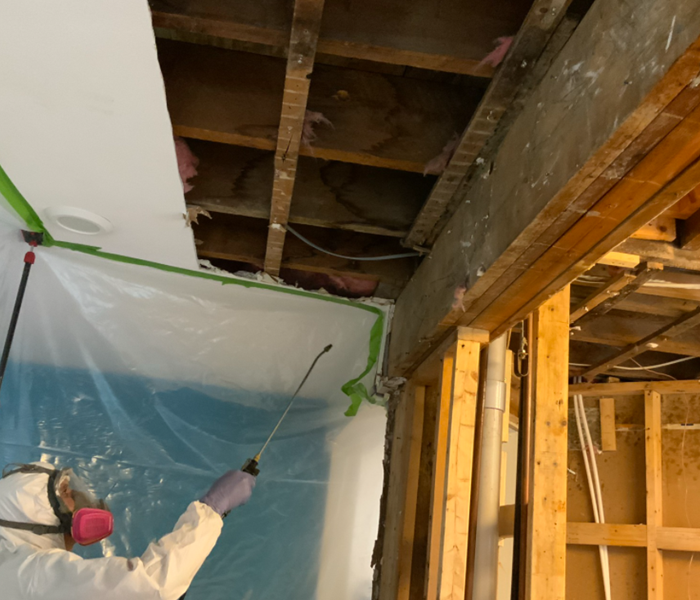 Trust us to get the job done right the first time!
Trust us to get the job done right the first time!
Every situation is different and may require a unique solution. However, the general process is always the same!
Step 1: Emergency Contact
We are always available for you in the event of a water emergency. When you call in, no matter the day or time someone will return your call. The main goal during the initial contact is to understand what is going on so we can dispatch someone to your home or business as soon as possible.
Step 2: Inspection and Assess Damage
When we arrive on site our goal is to know what caused the damage if it is not apparent. This way we can have the issue addressed. The damage may require a third party to be involved (ie. plumber). You may contact your own contractor we are also happy to provide a few recommendations. Once we know what has caused the damage we can continue move on to the next step!
Step 3: Water Removal/ Water Extraction
A licensed technician will use specialized water extraction equipment to remove water from your home. Removal and extraction may result in removal of flooring depending on the type of water damage (ie. sewage back up). Our technicians will document and removal items that cannot be restored.
Step 4: Drying and Dehumidification
We will place machines in your home or business to ensure the space is dry and prevent the possible growth of mold. The average run time for drying machines is between 3-5 days. Of course, it may be more or less depending on the extent of the water damage to your property. It is important that you not unplug or move the equipment from where they were placed by the technician to ensure the space dries properly.
Step 5: Cleaning and Repair
Our technicians will clean the affected area and neighboring areas with anti-microbial cleaning products to prevent the possible growth of mold. We ensure we clean every crack and crevice!
Step 6: Restoration
We have the capacity to put your home back to pre loss condition with our reconstruction team. When you are ready call our office to discuss with our Reconstruction Manager.
In all, the first few steps my take place upon the first to second visit. The remaining steps will depend on the extent of the damage. In situations where we are working with your insurance carrier we will happily communicate with your adjuster directly to keep the work moving smoothly so restoration can begin as soon as possible. For questions please do not hesitate to call our office at (617) 864-7378.
Where to Look for Water Leaks in Your Home | SERVPRO® of Cambridge/Belmont
11/8/2021 (Permalink)
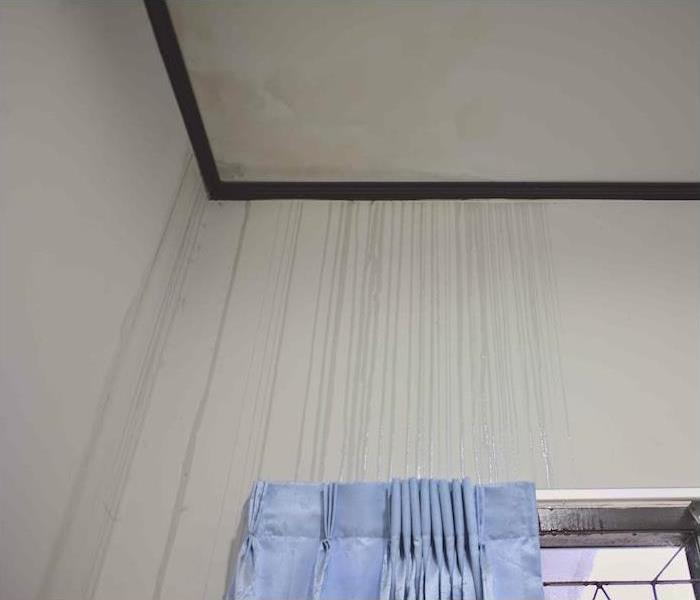 water leak can turn into a big problem. Contact the SERVPRO of Cambridge/Belmont team if you are dealing with any water damage.
water leak can turn into a big problem. Contact the SERVPRO of Cambridge/Belmont team if you are dealing with any water damage.
Water damage isn’t something anyone really wants to deal with. However, we never really get notice that a disaster is about to happen. Water is always looking for somewhere to go, and it seeks the path of least resistance.
Understanding your home water system can go a long way to preventing water damage. Practice preventive maintenance with an emphasis on the most common sources for water damage:
Toilet leaks. Whether it’s a broken wax seal or a clogged toilet, these have to be repaired quickly before more damage results. The tank has many moving parts, and these can wear out over time. Proper fixture maintenance in the bathroom can save you time and aggravation in the future.
Ice maker supply line. Ice maker supply lines are common sources of water leaks. If the line is damaged, replace it. If it’s loose, secure it.
Foundation cracks. Foundation cracks are serious and should be repaired by a professional. They can allow water to seep into the basement, and if your basement is finished living space, the damage can add up quickly.
Poor ventilation. Proper attic ventilation is important because it removes moisture from the attic that could condensate, drip and cause mold growth.
Roots in drain lines. Older homes have more problems with roots in the drain lines due to the types of materials that were used in construction. Septic systems utilize field lines, and they tend to attract tree roots due to the moisture in the ground.
Common drain issues. Homeowners face many issues with drain systems, including slow drains, recurring clogs, a foul odor or flooding from a backup.
Staying current on your home maintenance is the best way to avoid a potential catastrophe!
If a water leak erupts into a big problem at home, you’ve got the best team in the business on your side. Contact SERVPRO today so we can get started.
Avoiding Water Damage in Your Home
11/8/2021 (Permalink)
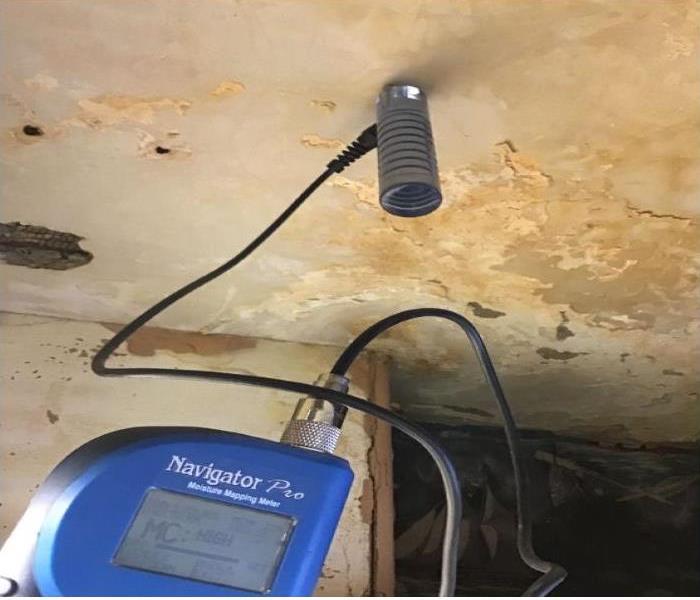 Get in touch if you are in need of water remediation
Get in touch if you are in need of water remediation
When it comes to keeping your home structurally sound and well-maintained, watching out for water damage is one of the best things you can do. Not only can water damage cause cosmetic problems and lead to unsightly spots throughout the home, but it can also significantly damage structures when it is allowed to fester.
Fortunately, homeowners can easily perform their own routine checks to look for water damage throughout the house, which can help them catch issues early and avoid having to make costly claims on their homeowners insurance.
Tips for Doing an At-Home Water Damage Inspection
Inspect your walls and ceilings. Drywall and paint can quickly show water damage, making walls and ceilings one of the best and easiest places to begin your search. Any discoloration, particularly soft spots or peeling areas of paint, might indicate that there is water damage present. It is also wise to check up on your external window and door frames for weather-related leakage.
Don’t forget to look down. It is not uncommon to find water damage that shows itself in the floor, since that is the lowest spot in every room. Water can pool and begin to saturate the subfloor, not causing surface issues but instead showing up with warped floorboards, buckling or a general smell of mildew, which should always be checked out.
Inspect your roof. It is important to keep your roof in good shape to make sure it is keeping out all the elements it can when it rains. A pair of binoculars can give you valuable insights into the quality of your roof and help you spot any loose shingles or peeling places. Additionally, it is smart to check that your gutters are doing their job the next time it rains to prevent water from building up around your foundation.
Pay close attention to the basement. Though basements have a reputation for being damp, if you have moisture problems under your home it can be a serious issue. Look for signs of water running down foundation walls or musty odors, which might indicate there is too much moisture present that should be addressed.
If you have water damage anywhere in your home, we are here to help. You can contact us at any hour to learn more about our services or to report damages. Get in touch today to speak with a water damage restoration expert.
Dishwashers - Water Damage
8/12/2021 (Permalink)
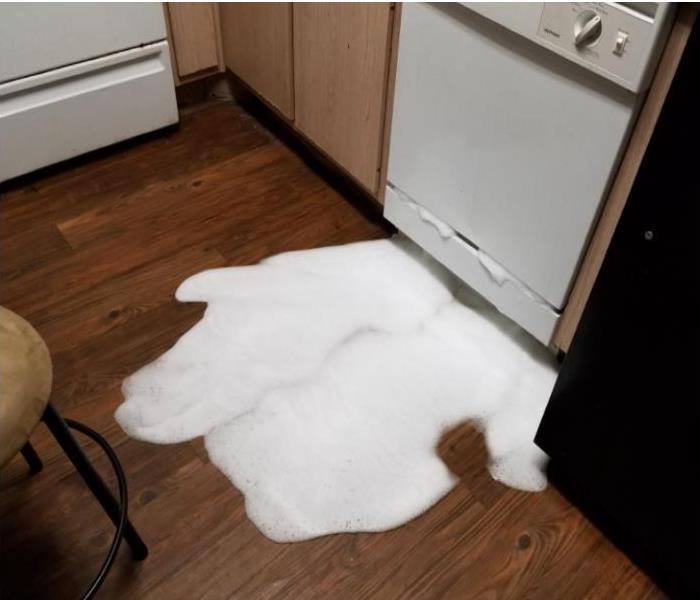 Simple repairs will save you in the long run
Simple repairs will save you in the long run
When to Fix: Common Dishwasher Issues
Typical dishwasher problems involve broken mechanical parts. Think a broken soap dispenser, dislodged sliding rack wheel, or broken sprayer arm.
When a dishwasher won’t drain, there’s usually something in the drain process that shouldn’t be there like lemon seeds, glass, plastic wrap or even bobby pins. “With a high-end dishwasher, you’ll get an OE overflow code. Often I can disconnect the machine, lean it forward, and drain it for a fix without having to replace any of the control boards,” says Craig.
In general, if you have to fix an issue but the unit is relatively new, it makes sense to fix if repair costs are under half the cost to replace the appliance. A good unit can last you 15-20 years if it’s well-maintained.
When to Replace: Do the Math
Once you start to replace the electronic boards, it gets expensive. On high-end dishwashers (KitchenAid, Samsung, Bosch) if the user control panel and the power control unit go out at the same time, it’s not worth it to repair it. “The parts alone will exceed $600 wholesale,” says Craig.
If a dishwasher is more than 7-10 years old and you’re paying more than half of the original cost in repairs, you should consider buying a new one.
Replacing a door latch can get pricey - this can run $200-250 for parts and labor and you can easily avoid this repair. If you want to add in dishes, don’t just pull it open. Hit pause and let the automatic lock release. It will save you money!”
Leaking is a big problem around the door or underneath where the motor or pumps assembly are. Costs vary depending on how old the unit is or if the control board is gone. Contact your local department store for most up to date pricing.
How to Avoid Issues
Don’t overload the machine and when you first have a problem, look at your model number and do some online research to learn about your machine. There might be an easy DIY fix for your symptoms. Or the manufacturer may offer a warranty.
Don’t run a garbage disposal at the same time the dishwasher is running. The two share the same plumbing, so if they’re going at the same time, you are more apt to kick debris into the dishwasher discharge line and clog it.
A little preventative maintenance goes a long way. Have a pro come every two years, clean out your lines and any calcium deposits, and get you running clean again. If the dishwasher does leak, call the preferred professional, SERVPRO of Cambridge/Belmont (617) 864-7378.
You Can Keep Heavy Rains From Damaging Your Belmont Home | SERVPRO® of Cambridge/Belmont
6/10/2021 (Permalink)
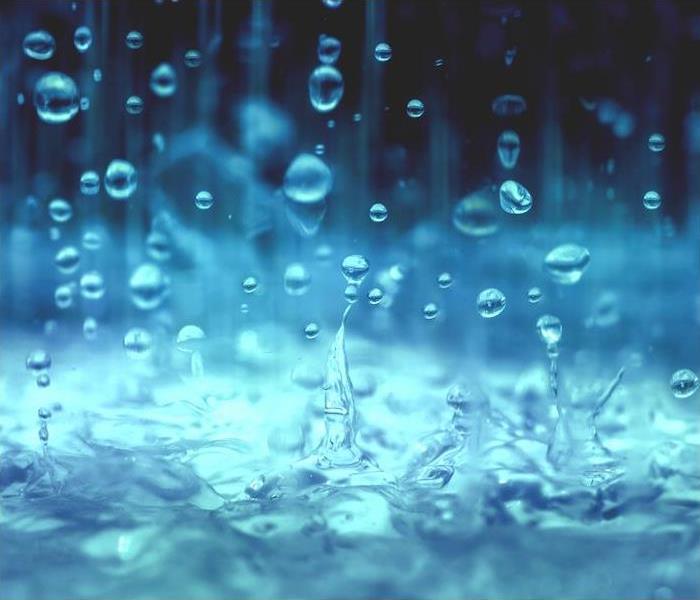 If you need help dealing with any damage caused by water, contact SERVPRO of Cambridge/Belmont today.
If you need help dealing with any damage caused by water, contact SERVPRO of Cambridge/Belmont today.
Water damage to your home can come from expected and unexpected sources. If you’re like most homeowners, you probably know that natural disasters (like flash floods) and home accidents (like plumbing failures) can cause water damage.
But have you thought about the damage heavy rains can do?
Heavy rains might not have been at the top of your list of water damage causes. But it can be a real problem for homeowners, and it’s common.
Drenching rainstorms are a common prediction during spring and summer forecasts. If your home is not properly maintained, these rains can cause costly damage.
Water Damage Is a Common Hazard
If you have to file a claim for water damage, you’ll be in good company. One in every 50 Americans will also be filing a claim this year. Depending on your neighborhood, that means several people you know may file a claim soon.
You can’t avoid all water damage hazards. Flash flooding can’t always be predicted and can cause serious damage to entire neighborhoods and communities.
But sometimes, homeowners can avoid the damage caused by heavy rains if they take the right steps.
Keep Your Home Safe During Heavy Rains
We see many water-damaged homes, so our teams have valuable insights into how you can protect your home from suffering water damage. Basic home maintenance can make a difference, and many of these projects might be on your list already.
Take stock of your yard. Knowing how your yard drains (and how it works with your home) is vital. If you notice that your yard is draining toward your home, then you might want to get in touch with a landscaping expert to look for ways to protect your yard.
Choose to landscape your yard thoughtfully. Many people choose plants and flowers because they like the aesthetic they create. But choosing landscaping items for protection can ensure your home is ready for heavy rain. Native plants, trees and bushes can be vital in protecting your home from water damage.
Look into sealing your roof. Experts estimate that almost 95% of damage is caused by water finding its way through gaps in your shingles, which can be prevented with this step.
If you need help dealing with damage caused by water, fire or any other issue, we’re here to help you restore your home. We have crews who are available 24⁄7 in the event of an emergency. Contact us at any time to learn more about us and how we can help you restore your home to its original state.
Reporting Water Damage
3/11/2021 (Permalink)
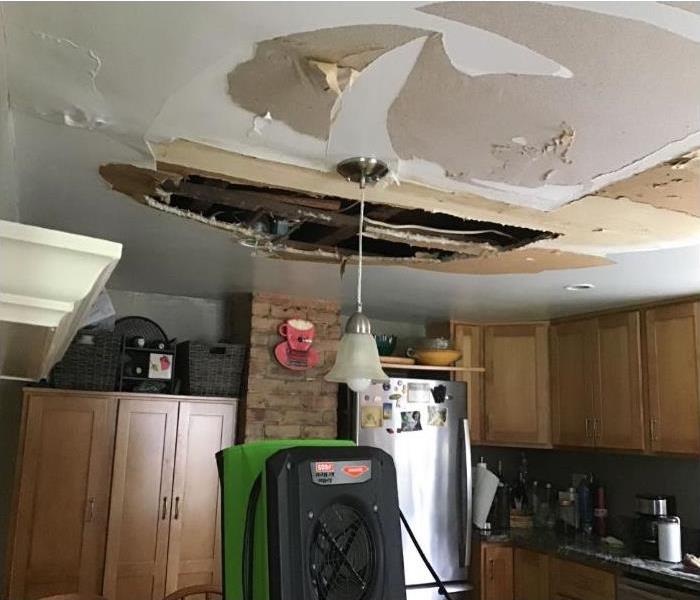 Do not wait call us as soon as you can if you experience water damage
Do not wait call us as soon as you can if you experience water damage
Town of Belmont 24 Hour Emergency Water Damage Service
SERVPRO of Cambridge/Belmont is available 24 hours a day for water emergencies, large or small. When you are dealing with water damage, immediate action is crucial. A delay of just a few hours can greatly increase the severity of the water damage.
We Answer the Phone Ready to Help
Call Today - (617) 489-7378
We understand that when you call us, you may be feeling confused, stressed, and vulnerable. You need an expert to guide you through this crisis. SERVPRO of Cambridge/Belmont has the specific water damage training and experience to help you through this tough time. We specialize in water damage restoration—in fact, it's the cornerstone of our business.
What to Expect
When you call, we will ask several questions regarding your water damage emergency. These questions will help us determine what equipment and resources to bring, including how many trained SERVPRO Professionals may be needed.
Our SERVPRO Representative will ask several questions:
Your name and contact information
Your insurance information (if applicable)
The street address of the water-damaged home or business
When did the flooding or water damage occur?
What caused the water damage (if known)?
Is there electricity available (on-site)?
About SERVPRO of Cambridge/Belmont
SERVPRO of Cambridge/Belmont specializes in the cleanup and restoration of residential and commercial property after a fire, smoke or water damage event. Our staff is highly trained in property damage restoration. From initial and ongoing training at SERVPRO’s corporate training facility to regular IICRC-industry certification, rest assured our staff is equipped with the knowledge to restore your property. SERVPRO of Cambridge/Belmont (617) 489-7378 – If you suspect you have water damage, Call us!
We are here to help!
3/11/2021 (Permalink)
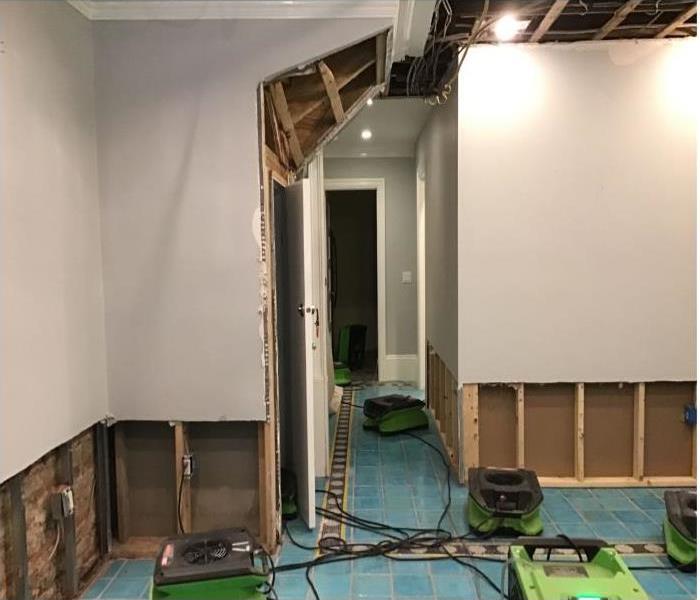 Call us when you need us 365 - 24/7
Call us when you need us 365 - 24/7
John & Sue Butler’s contractor had finally finished the renovations. They had been living with relatives until their new condominium was finished. The furniture and belongings were delivered and they were finally living in their dream home. They came home Sunday night after a weekend away and they noticed water dripping down from the ceiling. Their hardwood floors had standing water and were beginning to buckle. They discovered that their upstairs neighbor pipe broke causing the water to run down into their unit. They called SERVPRO of Cambridge/Belmont to assist them. The Butler’s explained that they had just moved in and didn’t want the life to be disrupted. The SERVPRO technician assessed the damages and came up with a plan that would not require any demolition. He discovered there were existing cavities he could install an Inject-I-Dry System that would dry out the floors & ceilings without any demolition or sanding. The technician monitored the drying progress and after one week, he determined that the floor and ceiling were dry and removed the equipment. The Butler’s were ecstatic!
If you sustain water damage, please call SERVPRO of Cambridge/Belmont (617) 864-7378 to assist you.
Planning Ahead in Case of a Burst Pipe | SERVPRO® of Cambridge/Belmont
12/14/2020 (Permalink)
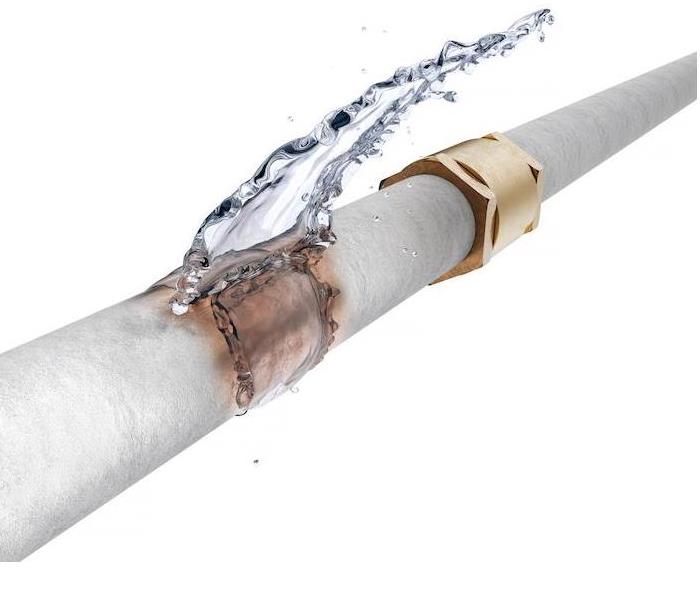 If you have water damage in your home due to a burst pipe or another cause, contact us right away. SERVPRO of Cambridge/Belmont is available 24/7.
If you have water damage in your home due to a burst pipe or another cause, contact us right away. SERVPRO of Cambridge/Belmont is available 24/7.
Burst pipes are something that can happen when you least expect it, causing serious damage in a brief amount of time. While there is no way to know when a pipe may burst, knowing what to do in the event that one does can help you act quickly to mitigate the damage that the water can cause.
In a perfect world, water damage would be a rare occurrence—but many people are surprised to find out how often it occurs. Every year, one in 50 homes will experience some type of water damage, but a plan can significantly lessen the impact that it has.
Having a Plan in the Event a Pipe Bursts in Your HomeShut off your water main. When a pipe bursts in your home, in some situations, it can continue pouring water into the area, creating even more damage. If it is safe to do so, shutting off your water main can reduce the overall damages that are caused.
Shut off your electricity. Water and electricity definitely do not mix, so if you are able to get to your circuit breaker to cut your electricity off safely, it is wise to do so. This will ensure that if water comes in contact with outlets or appliances, there is not a shock or fire hazard.
Contact your restoration company. Setting your restoration in motion quickly is one of the best things you can do for water damage, so it is wise to get in touch with your restoration company right away. We recommend always choosing a company that is available 24⁄7 so you never have to wait for a call back when you report your damages.
Take a record of the damages. Not only is keeping good records helpful for you, but it will also be helpful if you are eligible to file a claim with your insurance provider. Take photos and videos in addition to making a list of everything that is damaged by the water.
Contact your insurance company. The type of coverage you will receive for water damage of this nature can vary, so your insurance company is the authority on what is and is not eligible to be covered by filing a claim. Contacting them quickly can help you set this process in motion so you can get it settled as fast as possible.
Open windows and doors if possible. If the weather permits and it is safe to do so, increasing the airflow around water damage by opening windows and doors can speed up the drying time by encouraging evaporation.
If you have water damage in your home due to a burst pipe or another cause, you can count on us for restoration assistance. Contact us at any time to learn more about our restoration services.
How Can I Check for Water Damage in My Home? | SERVPRO® of Cambridge/Belmont
9/18/2020 (Permalink)
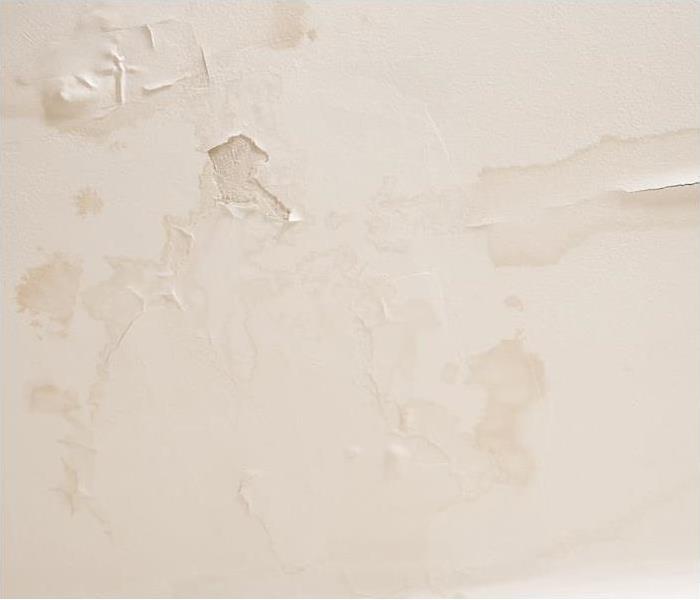 Do you have any water damage to your home? Contact SERVPRO of Cambridge/Belmont, we are your local water restoration experts.
Do you have any water damage to your home? Contact SERVPRO of Cambridge/Belmont, we are your local water restoration experts.
When it comes to keeping your home structurally sound and well-maintained, watching out for water damage is one of the best things you can do. Not only can water damage cause cosmetic problems and lead to unsightly spots throughout the home, but it can also significantly damage structures when it is allowed to fester.
Fortunately, homeowners can easily perform their own routine checks to look for water damage throughout the house, which can help them catch issues early and avoid having to make costly claims on their homeowners insurance.
Tips for Doing an At-Home Water Damage InspectionInspect your walls and ceilings. Drywall and paint can quickly show water damage, making walls and ceilings one of the best and easiest places to begin your search. Any discoloration, particularly soft spots or peeling areas of paint, might indicate that there is water damage present. It is also wise to check up on your external window and door frames for weather-related leakage.
Don’t forget to look down. It is not uncommon to find water damage that shows itself in the floor, since that is the lowest spot in every room. Water can pool and begin to saturate the subfloor, not causing surface issues but instead showing up with warped floorboards, buckling or a general smell of mildew, which should always be checked out.
Inspect your roof. It is important to keep your roof in good shape to make sure it is keeping out all the elements it can when it rains. A pair of binoculars can give you valuable insights into the quality of your roof and help you spot any loose shingles or peeling places. Additionally, it is smart to check that your gutters are doing their job the next time it rains to prevent water from building up around your foundation.
Pay close attention to the basement. Though basements have a reputation for being damp, if you have moisture problems under your home it can be a serious issue. Look for signs of water running down foundation walls or musty odors, which might indicate there is too much moisture present that should be addressed.
If you have water damage anywhere in your home, we are here to help. You can contact us at any hour to learn more about our services or to report damages. Get in touch today to speak with a water damage restoration expert.
Hot Water Heaters - When to Replace
8/11/2020 (Permalink)
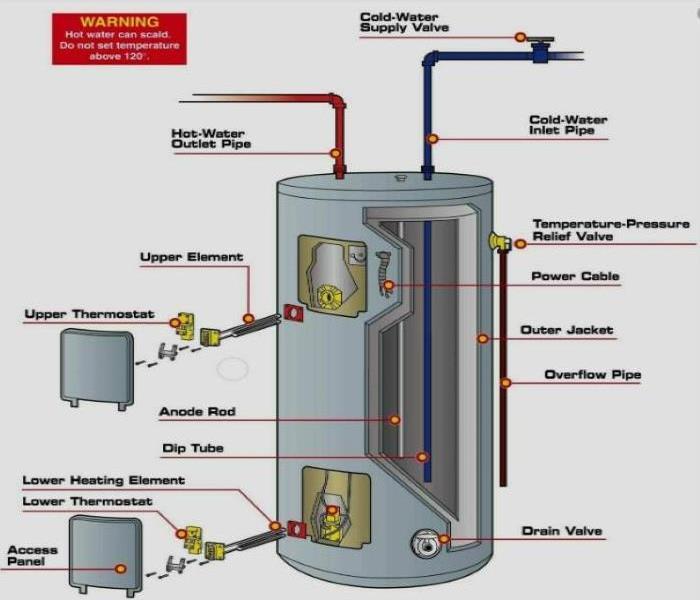 Check for signs that your water heater is ready for service or replacement
Check for signs that your water heater is ready for service or replacement
Water heaters are essential elements of our home. We use them in daily activities such as taking a bath, using the dishwasher and using the washing machine. But because we use them frequently, it’s sometimes easy to take them for granted and forget that they need to be maintained. Failing to do so will result in malfunctions and problems and eventually, replacing your water heater. Taking notice of the first signs of a problem can help you repair your water heater before it becomes worse.
You don’t have to be an expert to spot the first signs of trouble. All you need to have is a keen sense of observation so that your water heater can be repaired.
Here are three signs that indicate your water heater needs to be repaired.
Hot water has off smell or off color. The first instance that you notice your hot water has an off smell or has a rusty color, that’s something that you need to check out. The smell could be the result of a rusty anode rod in the water heater. There is no need to worry since the anode rod can be replaced that will then eliminate the bad odor. Bacteria growth also causes bad smells. This happens when the hot water has not been used or has been turned off for quite some time or when the thermostat is set at a very low level.
Corroded pipes can also cause an off color in your water. This can be solved by installing a water softener or by replacing the plumbing. If you also see a lot of sediments in the water, it’s time to have the water heater repaired.
Water is not hot enough, too hot, not strong enough or there is none at all. When there is no water, check first that your water heater has power and is working fine. If it is, have it inspected by a plumber. If water is not enough, this could be due to an undersized water heater and is a common situation when a lot more people are using the water heater. This could also be caused by the presence of mineral deposits inside the water heater tank. When water is too hot or not hot enough, you may have to adjust the temperature dial of the water heater. If there is no change in temperature, have the water heater checked and repaired.
Strange noises and leaks. Leaks coming from your water heater could lead to flooding. In the same way, strange noises like pops, bangs, gurgles, and the like are clear indicators that something is wrong with your water heater. This is usually caused by a buildup of sediments inside the tank. A boiling sound, however, could mean the water heater is overheating or that pressure is building up inside the tank. All these have to be addressed immediately to prevent further problems.
It’s important to have your water heater repaired as soon as you see these signs. This will help you save on costs, prevent further damage, and avoid an untimely replacement of your unit.
If your hot water heater malfunctions and creates a water damage, please call SERVPRO of Cambridge/Belmont (617) 864-7378 to assist you with the water damage.
Leaky Dishwasher
8/11/2020 (Permalink)
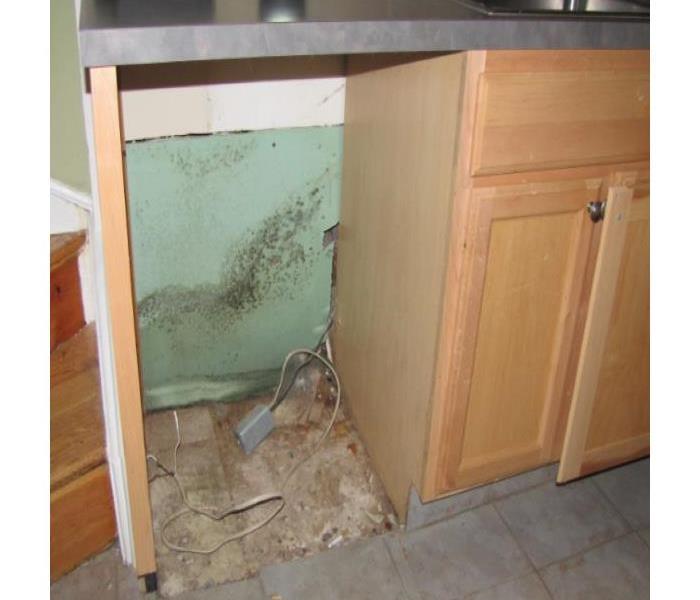 Leaky Dishwashers can be very expensive
Leaky Dishwashers can be very expensive
When to Fix: Common Dishwasher Issues
Typical dishwasher problems involve broken mechanical parts. Think a broken soap dispenser, dislodged sliding rack wheel, or broken sprayer arm.
When a dishwasher won’t drain, there’s usually something in the drain process that shouldn’t be there like lemon seeds, glass, plastic wrap or even bobby pins. “With a high-end dishwasher, you’ll get an OE overflow code. Often I can disconnect the machine, lean it forward, and drain it for a fix without having to replace any of the control boards,” says Craig.
In general, if you have to fix an issue but the unit is relatively new, it makes sense to fix if repair costs are under half the cost to replace the appliance. A good unit can last you 15-20 years if it’s well-maintained.
When to Replace: Do the Math
Once you start to replace the electronic boards, it gets expensive. On high-end dishwashers (KitchenAid, Samsung, Bosch) if the user control panel and the power control unit go out at the same time, it’s not worth it to repair it. “The parts alone will exceed $600 wholesale,” says Craig.
If a dishwasher is more than 7-10 years old and you’re paying more than half of the original cost in repairs, you should consider buying a new one.
Replacing a door latch can get pricey - this can run $200-250 for parts and labor and you can easily avoid this repair. If you want to add in dishes, don’t just pull it open. Hit pause and let the automatic lock release. It will save you money!”
Leaking is a big problem around the door or underneath where the motor or pumps assembly are. Costs vary depending on how old the unit is or if the control board is gone. Contact your local department store for most up to date pricing.
How to Avoid Issues
Don’t overload the machine and when you first have a problem, look at your model number and do some online research to learn about your machine. There might be an easy DIY fix for your symptoms. Or the manufacturer may offer a warranty.
Don’t run a garbage disposal at the same time the dishwasher is running. The two share the same plumbing, so if they’re going at the same time, you are more apt to kick debris into the dishwasher discharge line and clog it.
A little preventative maintenance goes a long way. Have a pro come every two years, clean out your lines and any calcium deposits, and get you running clean again. If the dishwasher does leak, call the preferred professional, SERVPRO of Cambridge/Belmont (617) 864-7378.
Non-Invasive drying reduces after damages
3/2/2020 (Permalink)
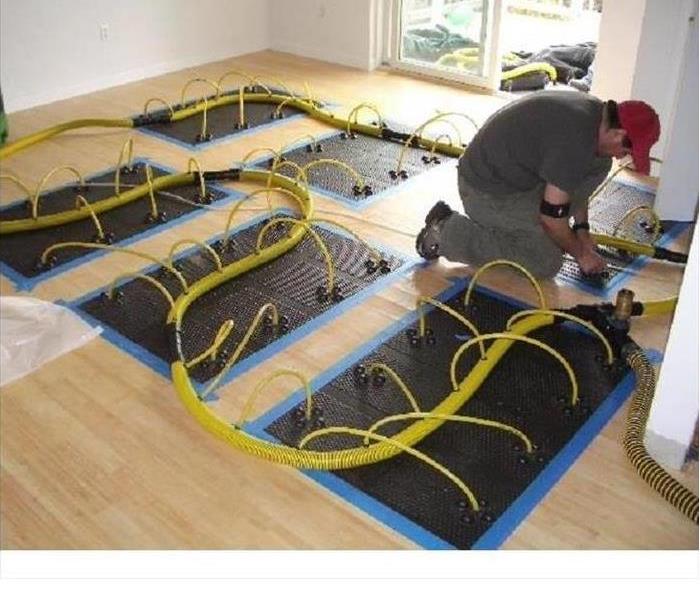 SERVPRO technician installing an Inject-I-Dry System to dry the hardwood floors.
SERVPRO technician installing an Inject-I-Dry System to dry the hardwood floors.
John & Sue Butler’s contractor had finally finished the renovations. They had been living with relatives until their new condominium was finished. The furniture and belongings were delivered and they were finally living in their dream home. They came home Sunday night after a weekend away and they noticed water dripping down from the ceiling. Their hardwood floors had standing water and were beginning to buckle. They discovered that their upstairs neighbor pipe broke causing the water to run down into their unit. They called SERVPRO of Cambridge/Belmont to assist them. The Butler’s explained that they had just moved in and didn’t want the life to be disrupted. The SERVPRO technician assessed the damages and came up with a plan that would not require any demolition. He discovered there were existing cavities he could install an Inject-I-Dry System that would dry out the floors & ceilings without any demolition or sanding. The technician monitored the drying progress and after one week, he determined that the floor and ceiling were dry and removed the equipment. The Butler’s were ecstatic!
If you sustain water damage, please call SERVPRO of Cambridge/Belmont (617) 864-7378 to assist you.
Tips to prevent damage to your home
2/20/2020 (Permalink)
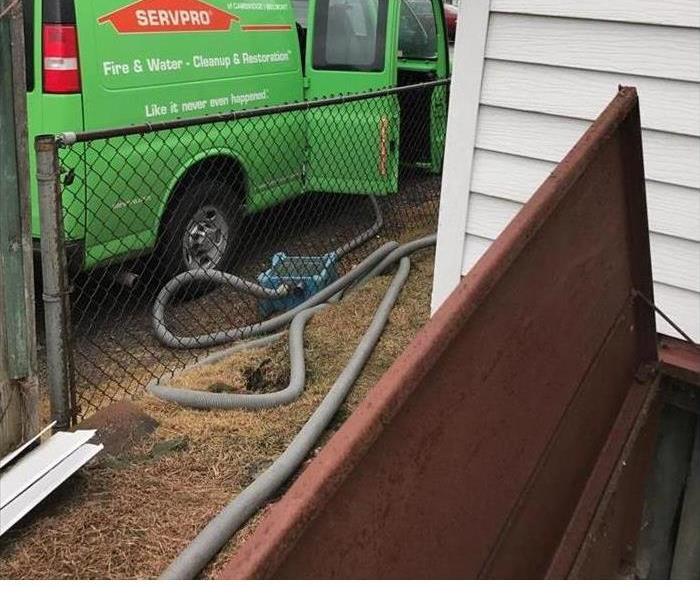 SERVPRO crew extracting water
SERVPRO crew extracting water
- Disconnect hoses
Standing water in a hose may freeze back into the pipe. This may create an ice block that stops your water flow. The block may may burst your pipes and create damage to walls, floor and foundation.
- Clean gutters and downspouts
Clean your gutters at least twice a year to avoid blockage and ice dams. Standing water can cause damage to your gutters and roof, and unmanaged overflow may create puddles that could damage your foundation.
Don't forget to clean downspouts to ensure water can flow through, and secure downspouts so that they point away from the home.
- Maintain trees and vegetation
Thriving shrubs can be a beautiful thing — except when their roots wrap around your pipes and break them. That's why it's important to minimize landscaping near utility pipes or, if necessary, remove trees and shrubs that have become too big.
Interior Measures to Prevent Water Damage
- Know your water main
Know the location of your water main, and shut it off if you leave for an extended amount of time. If no water goes in to the house, chances are no faucet drips can wreak havoc on your home while you're away.
- Check appliances regularly
Check and maintain your home appliances regularly for leaks, according to manufacturer's directions.
- Investigate leaks right away and fix promptly
If you opt to ignore moisture damage or postpone making the necessary repairs, be prepared to experience mold, mildew, dry rot, or even structural damage to your home.
Keep in mind that homeowner's insurance provides coverage for damage that is sudden and accidental. Damage that results from lack of maintenance is not covered on a standard homeowner’s insurance policy.
If it's too late and you're already dealing with a wet disaster, check out advice on how to minimize water damage in your home.
- Upgrade washing machine hoses
Old, brittle or leaky washing machine hoses are among the most frequent causes of water loss for homeowners. Replace yours regularly to avoid a mighty mess and expensive damage.
- Install water detection devices
A water detector is a small electronic device that sounds an alarm when its sensor comes in contact with moisture. Its main benefit is that it detects low moisture levels or slow leaks that often go unnoticed. Install it near water heaters, sump pumps, washing machines, dishwashers and toilets to prevent extensive damage and mold growth.
- Check your water pressure
If the water pressure to your home is set too high, pipes and hoses may fail under the pressure. Buy a water pressure gauge at a local hardware store, attach it to an outside faucet, and turn the faucet to full force. The gauge will give you a reading of the home’s water pressure.
Typical residential water systems are designed for water pressure of 40 to 70 psi. If your home’s water pressure exceeds 100 psi, install a pressure regulator (which is available at hardware stores as well.)
- Monitor your water bill
Sometimes, the only way you know that water is leaking is taking a closer look at your water bill. If your usage jumps significantly from one month to the next without explanation, put your "water detective hat" on. Is there a leak in your crawlspace? Or, is it a pipe in your front yard? Don't leave mystery leaks unattended!
If you have had water damage to your home please call SERVPRO of Cambridge/Belmont (617) 864-7378
Develop a relationship with a plumber
2/6/2020 (Permalink)
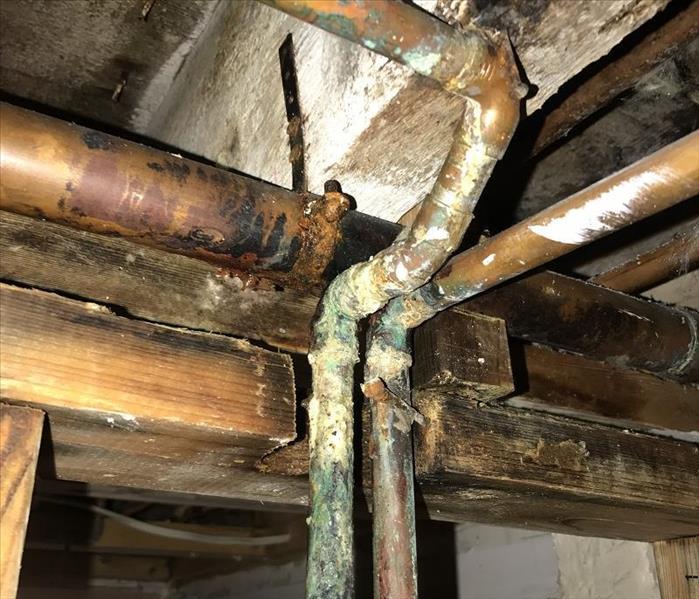 Better call your plumber
Better call your plumber
We depend on our plumbing each and every day, from the hot water in your shower to the water boiling on your stove. As such, it’s important to maintain your plumbing regularly to make sure there aren’t any major issues such as leaks or sewage backups. But plumbing problems can still occur with regular maintenance, so it’s good to be aware of common plumbing issues and what you can do to solve them or minimize damage to your home.
Low Water Pressure:
Proper water pressure is necessary for washing your hands, cleaning dishes, and taking a shower. If you’ve noticed a significant drop in your home’s water pressure, you probably have a clogged pipe. It’s also possible that you need to fully open your shutoff valve. If you’re only having water pressure issues with one faucet, the solution may be as simple as cleaning the aerator or removing a nearby clog.
Dripping Faucet:
Depending on the severity of the drip, a dripping faucet can raise your water bill and waste a significant amount of water—not to mention how annoying it can be. Luckily, fixing a dripping faucet is usually as simple as replacing seats and springs or a washer in the faucet.
Running Toilet:
It happens so frequently: minutes after flushing your toilet, you can still hear the toilet running as if the bowl is filling with water. This is an incredibly annoying problem to have, but usually, an easy one to fix. Remove the lid from your toilet tank and make sure that your tank ball, flapper valve, and flush valve are working properly—if any of them are sticking or not functioning right, they’re easy to replace.
Clogged Drain:
Clogged or slow drains are probably the most common plumbing problem. Plumbing pipes are designed to allow water and waste to flow through freely, but over time, built up hair, soap scum and other debris can form a clog in your drain that prevents water from passing. This is almost sure to happen in any home given enough time. You can use vinegar and baking soda to break up clogs in your sink, or you can buy a drain auger and remove the clog manually.
Sometimes the clog may be deeper in your pipes or too severe to easily remove, look into professional plumbing services; they have the equipment and expertise to clear clogged drains without causing damage to your plumbing. If you have sewage damage as a result of a clogged drain or other plumbing issues, please call SERVPRO of Cambridge/Belmont (617) 864-7378
Leaking Pipes:
Leaks aren’t just an annoyance; they can significantly increase your water bill and quickly cause damage to your home. If you have a leaking pipe that’s beyond a slow drip, shut your water off as soon as possible. If there is any chance of mold or structural damage to your home, call SERVPRO of Cambridge/Belmont (617) 864-7378 to avoid spending a fortune on repairs. Leaking pipes generally need to be replaced, but you can use marine tape or epoxy to cover small leaks temporarily—just remember to shut the water off first.
No Hot Water:
Have you ever rolled out of bed and into the shower only to find there’s no hot water? It’s not a good experience. Chances are you’ve got something wrong with your water heater, most probably an electrical problem such as a thermostat or element. If you’re not comfortable troubleshooting your water heater, it’s a good idea to get help from a trained, knowledgeable professional.
Plumbing truly is an essential part of our everyday lives. We can’t all be professional plumbers, but with a little bit of research and hard work, you can stay cool, calm and collected in the face of a plumbing emergency
If you have water damage as a result of any of these or other plumbing issues, please call SERVPRO of Cambridge/Belmont (617) 864-7378
Don't ignore small water leaks
1/28/2020 (Permalink)
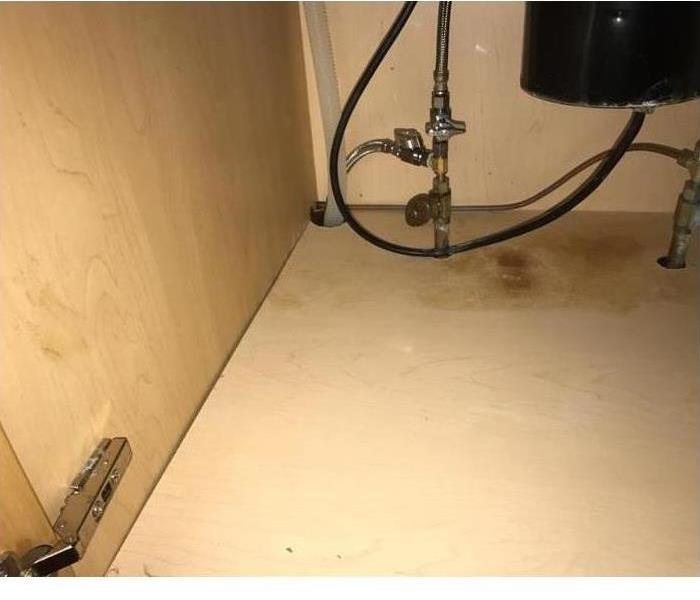 Leaky pipe causing staining under the kitchen sink
Leaky pipe causing staining under the kitchen sink
Whether it's behind the washer, above the ceiling or under the sink, a little drip can lead to big trouble. Water damage happens quickly and can be expensive to fix. Ignore a leak, and you not only could you have a mighty mess on your hands, but your home insurance probably won't bail you out. "What's really important to know for leaks is when did the insured notice it and take action," Says Michael Pridham from SERVPRO of Cambridge/Belmont
"People now build houses to be airtight," says Raffi Yardemian, owner of SERVPRO of Cambridge/Belmont, a property-damage restoration service. "Houses are wrapped in plastic like Saran Wrap. That's good for energy conservation, but if water gets on the wrong side of that plastic, then mold will follow, as certainly as night follows day." Yardemian observes that damage often occurs after people get security systems installed. Holes are drilled into airtight window frames for wires to run through them, but they aren't properly caulked and sealed, allowing water to slowly seep in over time. "You notice that maybe the wall below the window is looking funny, and by that time the framing behind it is rotted out," he says. If the homeowner reports the problem right away, it would likely be covered by home insurance.
Today's houses also have more bathrooms, and the washing machine is often located next to the master bedroom on an upper floor for convenience, Yardemian notes. "That means you've got more pipes, and if the washing machine leaks, it can affect the third floor, the second floor, the first floor and even down to the basement," he says. For water damage from leaky appliances or pipes, the damage must be "sudden and accidental" in order to be covered by insurance - such as a pipe that bursts while you're washing clothes.
But what about a slow leak you can't see? Say, for instance, a pipe behind a wall leaks, and you don't notice it until water starts seeping through the wall. Are you covered? Most likely the answer is yes, as long as you take action as soon as there is evidence of the leak, Yardemian says. "Nobody expects you to tear out your drywall now and again to check the pipes. Call the professionals at SERVPRO of Cambridge/Belmont (617) 864-7378. They will send out a crew to test the walls using moisture detectors and an infrared camera.
Insurance companies understand it's impossible to know you have a hidden leak until the damage becomes apparent. The same goes for leaks behind and under appliances, or above a ceiling. If you can't see the leak, you can still make an insurance claim as long as you report it when it becomes apparent. Don't expect much sympathy if you ignore the wet spot in your ceiling, only to report it when the problem gets worse. The insurance adjuster probably will be able to tell if the damage is fresh.
"If the insured had a leak in the roof and had a pot under it for six months, then that damage is not covered," Yardemian of SERVPRO of Cambridge/Belmont says. "Insurance Professionals are pretty good at seeing whether a wet spot has been there for a while. Sometimes they have engineers go out to look." When it comes to insurance coverage, everything depends on the language in your policy. Although most policies cover damage from leaks as long as you responded quickly, language among policies differs. Keep in mind, though, that while home insurance may cover the water damage to the ceiling, floor, walls or furniture, it won't pay for replacing the worn-out pipe or the leaky roof (unless the roof was damaged by a covered peril, such as hail or a fallen tree).
If you think you have a leak, call the professionals at SERVPRO of Cambridge/Belmont (617) 864-7378
Frigid weather coming to New England
11/12/2019 (Permalink)
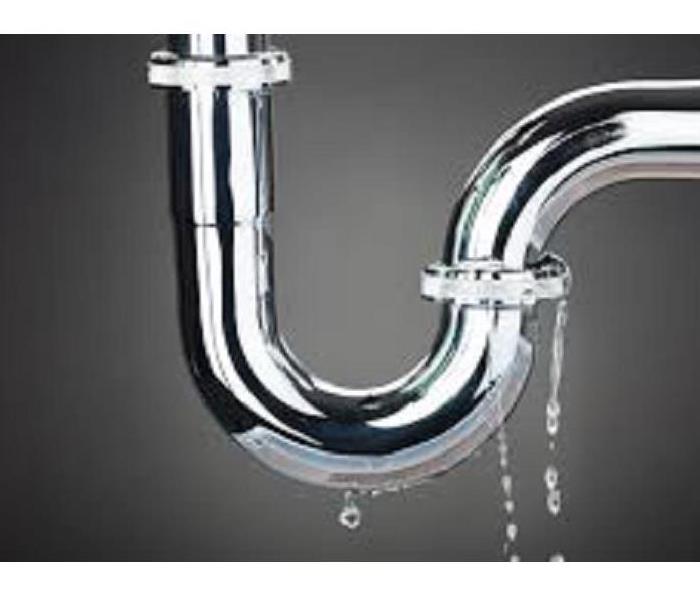 Kitchen drain pipe leaking due to a frozen pipe
Kitchen drain pipe leaking due to a frozen pipe
It is only mid November, forecasters anticipate that the mid and latter parts of this week will bring frigid temperatures in Cambridge and Belmont Massachusetts. Lengthy periods of sub-freezing temperatures mean an increased potential for frozen and burst pipes.
Here are a few tips to help safeguard your customers against frozen pipes:
Drain and shut off all outside spigots.
Leave the heat up! Set the thermostat and leave it set to the same temperature day and night.
Open the kitchen and bathroom cabinet doors to allow warm air to circulate around plumbing.
If you have an attached garage, keep the doors shut. Wind and cold air drafts increase the likelihood of a frozen pipe.
If you are going away, shut off the water supply line to your washing machine.
Have someone check on the house if you are going away for an extended period of time. Once the ice melts and the temperatures rise, the water will start to flow.
Mark the main water supply line so it can be easily identified in the event it needs to be shut off in an emergency.
If you experience an issue, please call SERVPRO of Cambridge/Belmont (617) 864-7378 to assist you.
Moisture in your home
11/5/2019 (Permalink)
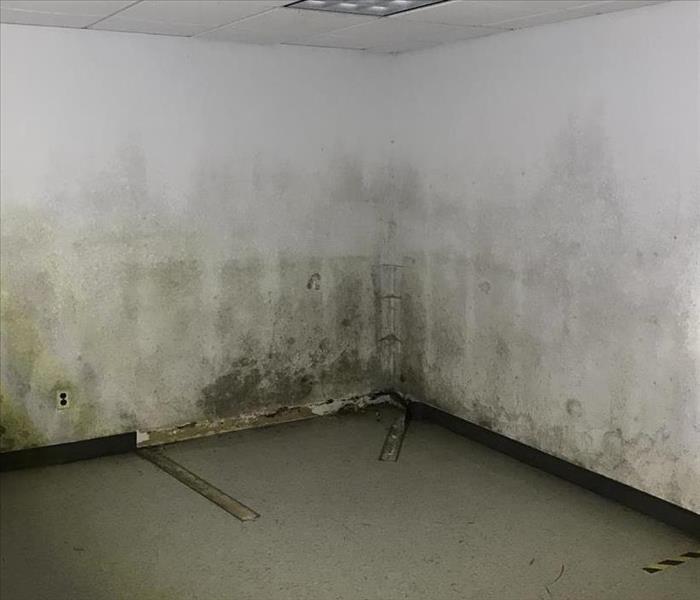 Excessive moisture in your basement may cause mold growth if dehumidification is not done.
Excessive moisture in your basement may cause mold growth if dehumidification is not done.
1) – Your home produces moisture.
Any household produces moisture by cooking, washing, bathing and exercising. Even breathing brings moisture into the air. Your family and pets bring many liters of water into your home every day. Moisture can also enter your house from the soil through the basement or crawl space.
2) – High humidity is not healthy
Humidity is important for our health. A normal humidity level is needed for feeling comfortable. However, too much moisture in your home can cause big problems and even negatively affect your health. Microorganisms that thrive in humid conditions are of special concern as they can help cause allergies and asthmatic conditions.
3) - Low humidity is not healthy either
Low humidity can, in turn, have all kinds of unpleasant effects. Your skin can feel dry, your lips can start to chap and your eyes can start to itch. Sore eyes, difficulty breathing and painful sinuses are also common problems caused by too dry air. This is especially true in winter when the outside air tends to be very dry. Air conditioned spaces, including airplanes and offices, are also well known ‘dry zones.’
4) – Bugs and mold love a humid home
Bugs thrive in humid conditions. Dust mites especially love warm temperatures (23-27 degrees Celsius / 75-80 degrees Fahrenheit) and high humidity levels of 70-80%. One study has found that mite populations stop growing and die out when relative humidity levels drop below 60%. Air conditioning has been proven to lower dust mite allergens in homes by lowering the ambient temperature and relative humidity. Mold loves humid conditions as well. When the relative humidity is higher than 80%, mold is likely to develop more than 50% of the time. Their spores are known to contribute to the development of asthma in children and cause allergies.
5) – Moisture is the No. 1 electronics killer
Excess moisture can not only damage your health, but also damage your possessions. Electronics are especially susceptible to damage by condensation. Moisture can corrode contacts inside and lower insulation resistance, which may cause short circuits. Watch for high humidity and drastic temperature changes that occur when bringing in electric appliances from your cold garage or basement. Take care to let them adjust to the climate before switching them on. You can protect stored electronics or other valuables by putting them in closed plastic boxes with a small dehumidifying satchel/bag.
6) – Winter is the real humid season for homes
The air is often cold and dry in the winter. While your lips, skin and nails suffer due to all that winter dryness, your house might suffer from the effects of excess moisture because two things happen:
Winter is the heating season. We close our windows and reduce ventilation and circulation of air in our homes to keep out the cold. At the same time, rain and melting snow can increase the amount of moisture entering your house through crawl spaces, basements and walls. Because less moisture leaves the house, humidity levels inside can start to rise.
At the same time, something else happens. Parts of your house that are in direct contact with the cold outside air are cooler than the air inside. Examples are single glazed windows and walls with low insulation. The temperature difference with the warm, moist air inside can cause continuous condensation to occur on those cold surfaces. All that wetness will attract mold growth and cause moisture stains.
7) – Ventilation is essential
Especially areas that produce a lot of moisture like bathrooms, kitchens and bedrooms need lots of ventilation. In some areas, it is simply not possible, cost effective or energy efficient to ventilate continuously. For those areas, there are many great solutions out there. Check our dehumidifier section for suggestions.
8) – Humidity is always relative
So what exactly is “humidity,” anyway? Humidity is the amount of moisture or water vapor in the air. However, you will usually hear the term “relative humidity.” Why “relative”? Because the maximum amount of water the air can “hold” depends on the temperature of the air. A relative humidity of 100% means the air contains the maximum amount of water it can hold at that specific temperature. Warmer air can hold more water than colder air.
So, what happens when warm humid air cools down? The colder air can hold less moisture and might “drop” some of it. This happens most easily when warm, humid air comes into contact with a cold surface (like a cool soda bottle in summer or windows in winter). Water released by the air in this way is called “condensation,” which can cause serious problems in your home, car, boat or RV.
9) – The ideal humidity level is 40-60%
Opinions on the ideal relative humidity level in your home vary somewhat. Generally, it is thought best to be in the 40-60% range. Moving outside this range for a short period is not likely to cause you any discomfort. Negative effects are most likely to occur when parts of your home are continuously exposed to high humidity.
10) – Humidity can be controlled
There are many solutions available to help you maintain healthy humidity levels and moisture problems. You can use a hydrometer to monitor the inside air and there are all kinds of commercial dehumidifiers and humidifiers out there. They all have their advantages and disadvantages.
If you require help with any moisture issues in your home, please call SERVPRO of Cambridge/Belmont (617) 864-7378
10 common moisture problems in the home
7/23/2019 (Permalink)
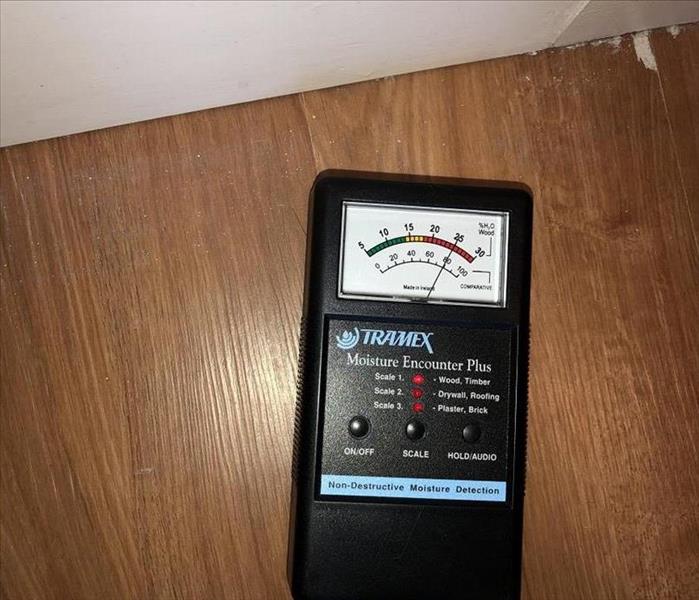 Moisture meter showing excessive moisture levels
Moisture meter showing excessive moisture levels
Must-know no. 1 – Your home produces moisture. Loads of it!
Any household produces moisture by cooking, washing, bathing and exercising. Even breathing brings moisture into the air. Your family and pets bring many liters of water into your home every day. Moisture can also enter your house from the soil through the basement or crawl space.
Must-know no. 2 – Too high humidity is not healthy…
Humidity is important for our health. A normal humidity level is needed for feeling comfortable. However, too much moisture in your home can cause big problems and even negatively affect your health. Microorganisms that thrive in humid conditions are of special concern as they can help cause allergies and asthmatic conditions.
Must-know no. 3 – … and neither is too low humidity
Low humidity can, in turn, have all kinds of unpleasant effects. Your skin can feel dry, your lips can start to chap and your eyes can start to itch. Sore eyes, difficulty breathing and painful sinuses are also common problems caused by too dry air. This is especially true in winter when the outside air tends to be very dry. Air conditioned spaces, including airplanes and offices, are also well known ‘dry zones.’
Must- know no. 4 – Bugs and mold love a humid home
Bugs thrive in humid conditions. Dust mites especially love warm temperatures (23-27 degrees Celsius / 75-80 degrees Fahrenheit) and high humidity levels of 70-80%. One study has found that mite populations stop growing and die out when relative humidity levels drop below 60%. Air conditioning has been proven to lower dust mite allergens in homes by lowering the ambient temperature and relative humidity. Mold loves humid conditions as well. When the relative humidity is higher than 80%, mold is likely to develop more than 50% of the time. Their spores are known to contribute to the development of asthma in children and cause allergies.
Must-know no. 5 – Moisture is the No. 1 electronics killer
Excess moisture can not only damage your health, but also damage your possessions. Electronics are especially susceptible to damage by condensation. Moisture can corrode contacts inside and lower insulation resistance, which may cause short circuits. Watch for high humidity and drastic temperature changes that occur when bringing in electric appliances from your cold garage or basement. Take care to let them adjust to the climate before switching them on. You can protect stored electronics or other valuables by putting them in closed plastic boxes with a small dehumidifying satchel/bag.
Must-know no. 6 – Winter is the real humid season
The air is often cold and dry in the winter. While your lips, skin and nails suffer due to all that winter dryness, your house might suffer from the effects of excess moisture because two things happen:
Winter is the heating season. We close our windows and reduce ventilation and circulation of air in our homes to keep out the cold. At the same time, rain and melting snow can increase the amount of moisture entering your house through crawl spaces, basements and walls. Because less moisture leaves the house, humidity levels inside can start to rise.
At the same time, something else happens. Parts of your house that are in direct contact with the cold outside air are cooler than the air inside. Examples are single glazed windows and walls with low insulation. The temperature difference with the warm, moist air inside can cause continuous condensation to occur on those cold surfaces. All that wetness will attract mold growth and cause moisture stains.
Must-know no. 7 – Ventilation is essential
Especially areas that produce a lot of moisture like bathrooms, kitchens and bedrooms need lots of ventilation. In some areas, it is simply not possible, cost effective or energy efficient to ventilate continuously.
Must-know no. 8 – Humidity is always relative
So what exactly is “humidity,” anyway? Humidity is the amount of moisture or water vapor in the air. However, you will usually hear the term “relative humidity.” Why “relative”? Because the maximum amount of water the air can “hold” depends on the temperature of the air. A relative humidity of 100% means the air contains the maximum amount of water it can hold at that specific temperature. Warmer air can hold more water than colder air.
So, what happens when warm humid air cools down? The colder air can hold less moisture and might “drop” some of it. This happens most easily when warm, humid air comes into contact with a cold surface (like a cool soda bottle in summer or windows in winter). Water released by the air in this way is called “condensation,” which can cause serious problems in your home, car, boat or RV.
Must-know no. 9 – The ideal humidity level is 40-60%
Opinions on the ideal relative humidity level in your home vary somewhat. Generally, it is thought best to be in the 40-60% range. Moving outside this range for a short period is not likely to cause you any discomfort. Negative effects are most likely to occur when parts of your home are continuously exposed to high humidity.
Must-know no. 10 – Humidity can be controlled
There are many solutions available to help you maintain healthy humidity levels and moisture problems. You can use a hydrometer to monitor the inside air and there are all kinds of commercial dehumidifiers and humidifiers out there. They all have their advantages and disadvantages.
If you have a moisture/water problem, please call SERVPRO of Cambridge/Belmont (617) 489-7378
Basement Flooding Belmont, MA
6/6/2019 (Permalink)
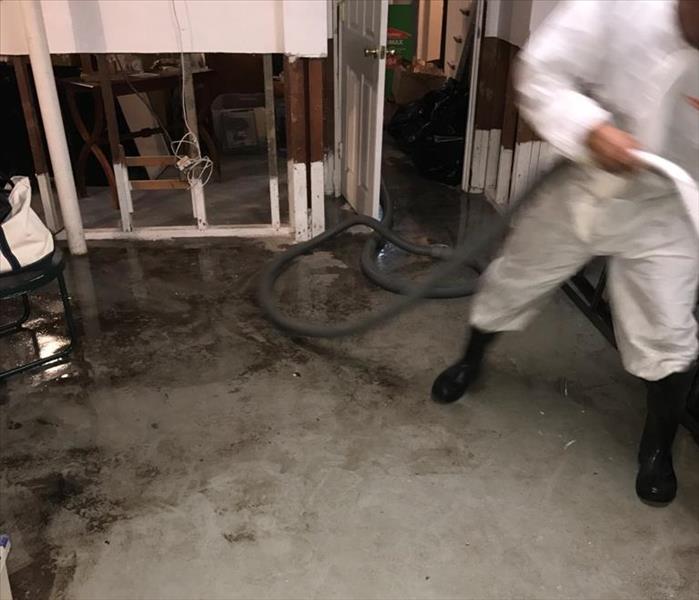 Flooded basement in Belmont, MA
Flooded basement in Belmont, MA
Town of Belmont 24 Hour Emergency Water Damage Service
SERVPRO of Cambridge/Belmont is available 24 hours a day for water emergencies, large or small. When you are dealing with water damage, immediate action is crucial. A delay of just a few hours can greatly increase the severity of the water damage.
We Answer the Phone Ready to Help
Call Today - (617) 489-7378
We understand that when you call us, you may be feeling confused, stressed, and vulnerable. You need an expert to guide you through this crisis. SERVPRO of Cambridge/Belmont has the specific water damage training and experience to help you through this tough time. We specialize in water damage restoration—in fact, it's the cornerstone of our business.
What to Expect
When you call, we will ask several questions regarding your water damage emergency. These questions will help us determine what equipment and resources to bring, including how many trained SERVPRO Professionals may be needed.
Our SERVPRO Representative will ask several questions:
Your name and contact information
Your insurance information (if applicable)
The street address of the water-damaged home or business
When did the flooding or water damage occur?
What caused the water damage (if known)?
Is there electricity available (on-site)?
About SERVPRO of Cambridge/Belmont
SERVPRO of Cambridge/Belmont specializes in the cleanup and restoration of residential and commercial property after a fire, smoke or water damage event. Our staff is highly trained in property damage restoration. From initial and ongoing training at SERVPRO’s corporate training facility to regular IICRC-industry certification, rest assured our staff is equipped with the knowledge to restore your property. SERVPRO of Cambridge/Belmont (617) 489-7378 – If you suspect you have water damage, Call us!
Appliance do's & don'ts
6/6/2019 (Permalink)
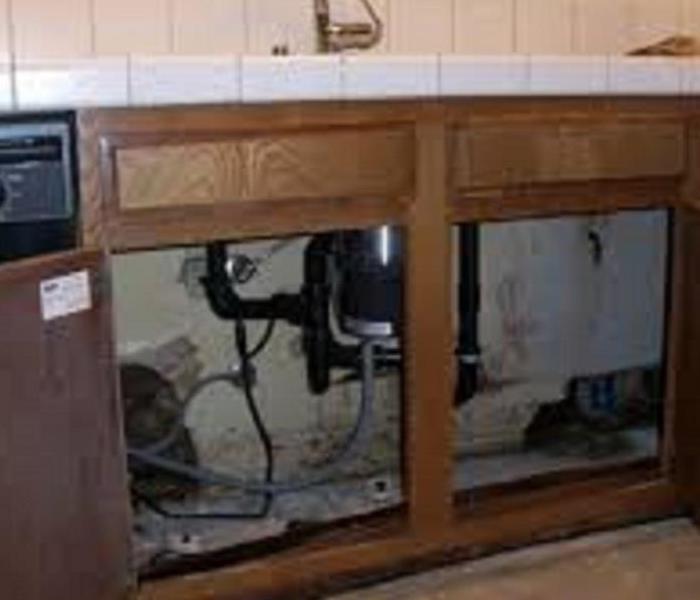 Effects of a leaking Dishwasher
Effects of a leaking Dishwasher
Has your dishwasher stopped draining? Did you accidentally break the sliding rack? Have the buttons just stopped working? You need a repair pro. We asked Sergio Rodrigues of SERVPRO of Cambridge/Belmont and Craig Kimble of We Can Fix That to share their best tips for when to repair an ailing appliance, when to replace it and what to do if it begins to leak water.
Typical Appliance problems involve broken mechanical parts, says Craig of We Can Fix That. Think a broken soap dispenser, dislodged sliding rack wheel, or broken sprayer arm in a dishwasher.
When a Dishwasher won’t drain, there’s usually something in the drain process that shouldn’t be there like lemon seeds, glass, plastic wrap or even bobby pins. “With a high-end dishwasher, you’ll get an OE overflow code. Often I can disconnect the machine, lean it forward, and drain it for a fix without having to replace any of the control boards,” says Craig.
In general, if you have to fix an issue but the unit is relatively new, it makes sense to fix if repair costs are under half the cost to replace the appliance. A good unit can last you 15-20 years if it’s well-maintained.
When to Replace: Do the Math
Once you start to replace the electronic boards, it gets expensive. On high-end dishwashers (KitchenAid, Samsung, Bosch) if the user control panel and the power control unit go out at the same time, it’s not worth it to repair it. “The parts alone will exceed $600 wholesale,” says Craig.
If a dishwasher is more than 7-10 years old and you’re paying more than half of the original cost in repairs, you should consider buying a new one.
How to Avoid Issues
Don’t run a garbage disposal at the same time the dishwasher is running, urges Michael of SERVPRO of Cambridge/Belmont. The two share the same plumbing, so if they’re going at the same time, you are more apt to kick debris into the dishwasher discharge line and clog it.
A little preventative maintenance goes a long way. Have a pro come every two years, clean out your lines and any calcium deposits, and get you running clean again. If the dishwasher does leak, call the preferred professional, SERVPRO of Cambridge/Belmont (617) 864-7378.
Common Plumbing Issues in your home
6/6/2019 (Permalink)
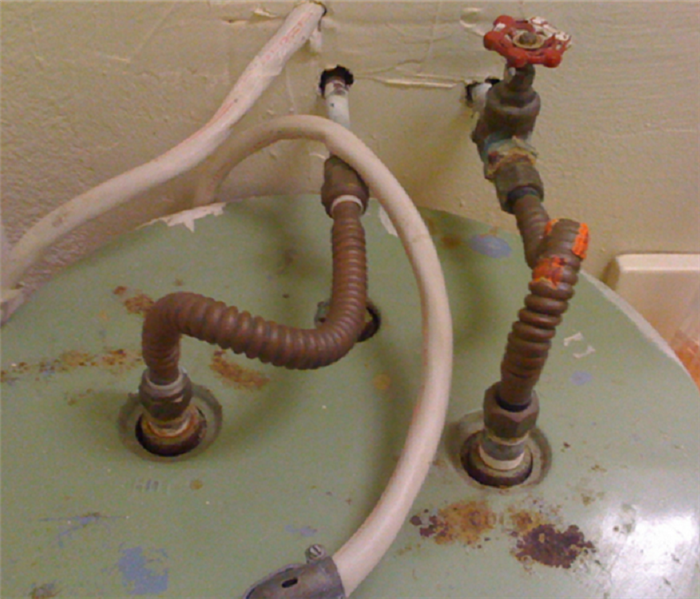 Old, Rusty Hot Water Heater
Old, Rusty Hot Water Heater
You depend on your plumbing each and every day, from the hot water in your shower to the water boiling on your stove. As such, it’s important to maintain your plumbing regularly to make sure there aren’t any major issues such as leaks or sewage backups. But plumbing problems can still occur with regular maintenance, so it’s good to be aware of common plumbing issues and what you can do to solve them or minimize damage to your home.
Low Water Pressure
Proper water pressure is necessary for washing your hands, cleaning dishes, and taking a shower. If you’ve noticed a significant drop in your home’s water pressure, you probably have a clogged pipe. It’s also possible that you need to fully open your shutoff valve. If you’re only having water pressure issues with one faucet, the solution may be as simple as cleaning the aerator or removing a nearby clog.
Dripping Faucet
Depending on the severity of the drip, a dripping faucet can raise your water bill and waste a significant amount of water—not to mention how annoying it can be. Luckily, fixing a dripping faucet is usually as simple as replacing seats and springs or a washer in the faucet.
Running Toilet
It happens so frequently: minutes after flushing your toilet, you can still hear the toilet running as if the bowl is filling with water. This is an incredibly annoying problem to have, but usually, an easy one to fix. Remove the lid from your toilet tank and make sure that your tank ball, flapper valve, and flush valve are working properly—if any of them are sticking or not functioning right, they’re easy to replace.
Clogged Drain
Clogged or slow drains are probably the most common plumbing problem. Plumbing pipes are designed to allow water and waste to flow through freely, but over time, built up hair, soap scum and other debris can form a clog in your drain that prevents water from passing. This is almost sure to happen in any home given enough time. You can use vinegar and baking soda to break up clogs in your sink, or you can buy a drain auger and remove the clog manually.
Sometimes the clog may be deeper in your pipes or too severe to easily remove, look into professional plumbing services; they have the equipment and expertise to clear clogged drains without causing damage to your plumbing. If you have sewage damage as a result of a clogged drain or other plumbing issues, please call SERVPRO of Cambridge/Belmont (617) 864-7378
Leaking Pipes
Leaks aren’t just an annoyance; they can significantly increase your water bill and quickly cause damage to your home. If you have a leaking pipe that’s beyond a slow drip, shut your water off as soon as possible. If there is any chance of mold or structural damage to your home, call SERVPRO of Cambridge/Belmont (617) 489-7378 to avoid spending a fortune on repairs. Leaking pipes generally need to be replaced, but you can use marine tape or epoxy to cover small leaks temporarily—just remember to shut the water off first.
No Hot Water
Have you ever rolled out of bed and into the shower only to find there’s no hot water? It’s not a good experience. Chances are you’ve got something wrong with your water heater, most probably an electrical problem such as a thermostat or element. If you’re not comfortable troubleshooting your water heater, it’s a good idea to get help from a trained, knowledgeable professional.
Plumbing truly is an essential part of our everyday lives. We can’t all be professional plumbers, but with a little bit of research and hard work, you can stay cool, calm and collected in the face of a plumbing emergency
If you have water damage as a result of any of these or other plumbing issues, please call SERVPRO of Cambridge/Belmont (617) 864-7378
24 Hour Water damage assistance
5/22/2019 (Permalink)
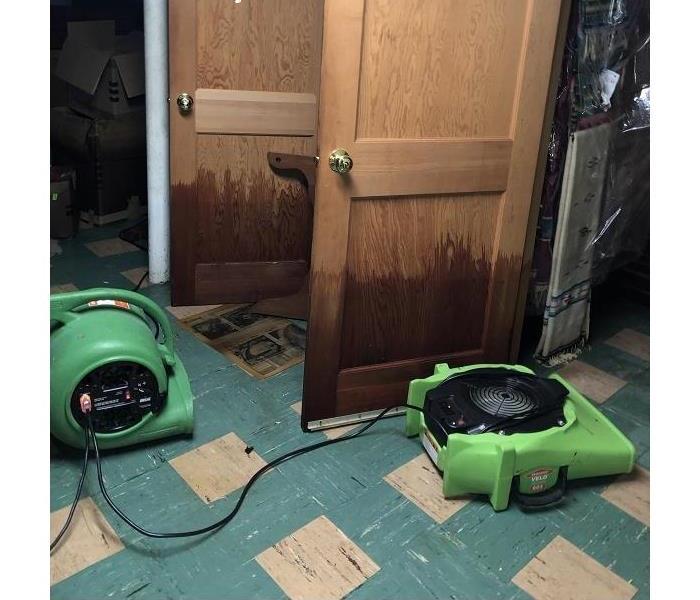 Flooded basement due to a hot water heater
Flooded basement due to a hot water heater
24 Hour Emergency Water Damage Service – SERVPRO of Cambridge/Belmont
SERVPRO of Cambridge/Belmont is available 24 hours a day for water emergencies, large or small. When you are dealing with water damage, immediate action is crucial. A delay of just a few hours can greatly increase the severity of the water damage.
We Answer the Phone Ready to Help
Call Today - (617) 864-7378
We understand that when you call us, you may be feeling confused, stressed, and vulnerable. You need an expert to guide you through this crisis. SERVPRO of Cambridge/Belmont has the specific water damage training and experience to help you through this tough time. We specialize in water damage restoration—in fact, it's the cornerstone of our business.
What to Expect: When you call, we will ask several questions regarding your water damage emergency. These questions will help us determine what equipment and resources to bring, including how many trained SERVPRO Professionals may be needed.
Our SERVPRO Representative will ask several questions:
Your name and contact information
Your insurance information (if applicable)
The street address of the water-damaged home or business
When did the flooding or water damage occur?
What caused the water damage (if known)?
Is there electricity available (on-site)?
About SERVPRO of Cambridge/Belmont
SERVPRO of Cambridge/Belmont specializes in the cleanup and restoration of residential and commercial property after a fire, smoke or water damage event. Our staff is highly trained in property damage restoration. From initial and ongoing training at SERVPRO’s corporate training facility to regular IICRC-industry certification, rest assured our staff is equipped with the knowledge to restore your property
Flood Insurance, do you need it?
5/2/2019 (Permalink)
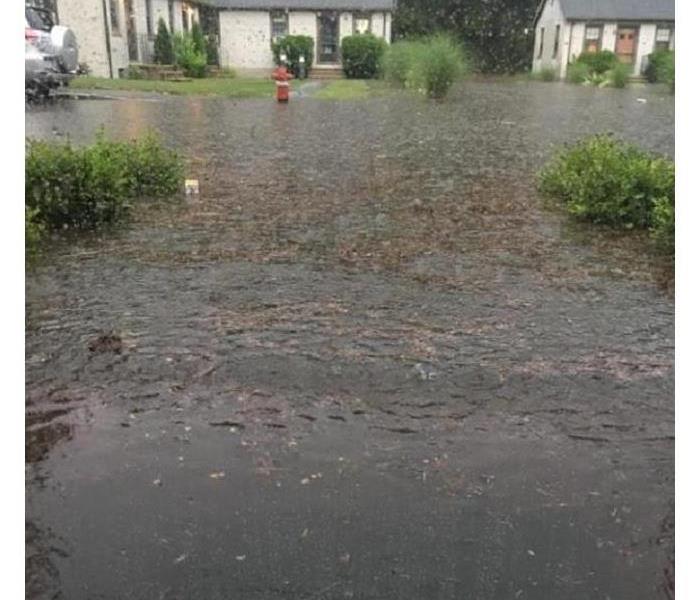 Spring rain can cause a flood very quickly
Spring rain can cause a flood very quickly
The fact is – any property can flood. Your home doesn’t have to be under five feet of water from hurricane flood surges to suffer flood damage. Normal amounts of rainwater can drain under your home, and flood your basement or the lowest floor level, causing flood damage. This kind of flooding can cause mold, increase the risk of termites and cause electrical problems.
More than 75% of homeowners devastated by flooding unfortunately discover they should have had flood insurance. The sad thing, experts say, is that flood insurance is not that expensive – typically $450 to $600 a year for the average home. When you weigh the cost of flood insurance against replacing your entire home $100,000 to $500,000, it only makes sense to buy it, whether you believe you’ll need it or not.
“People may say things like, ‘I live on a hill, I don’t need flood insurance’,” Diana Herrera, a FEMA flood insurance specialist said. “If I had a dollar for every time I’ve heard that, and those homes were flooded…”
Other common reasons people give for not buying flood insurance include:
- “I’m not in a flood zone.”
- “I’m not anywhere near water.”
- “I’ll never need it, it’s money wasted.”
- “My homeowner’s insurance will cover it.”
- “It’s not available.”
- “My realtor told me the property would never flood.”
If you sustain water damage from a flood, call SERVPRO of Cambridge/Belmont (617) 864-7378 to assist you.
Important information to prevent water damage to your home
7/26/2018 (Permalink)
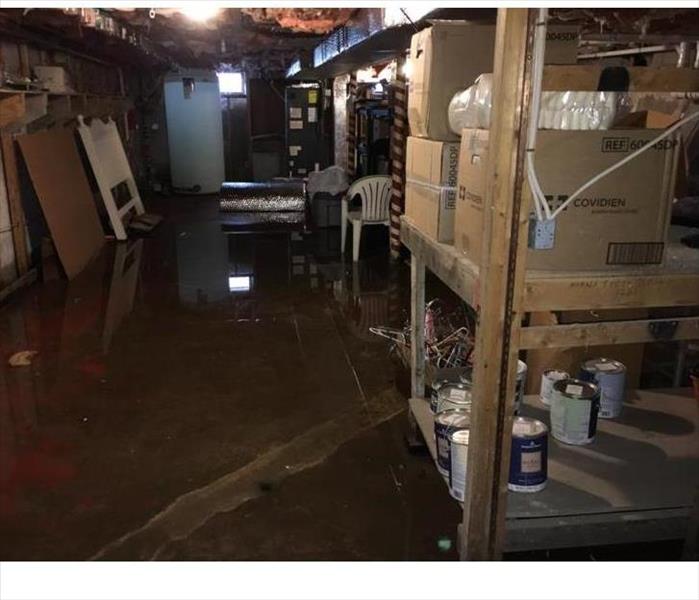 Old pipe caused water damage to the basement
Old pipe caused water damage to the basement
Exterior Measures
Disconnect hoses - Standing water in a hose may freeze back into the pipe. This may create an ice block that stops your water flow. The block may burst your pipes and create damage to walls, floor and foundation.
Clean gutters and downspouts - Clean your gutters at least twice a year to avoid blockage and ice dams. Standing water can cause damage to your gutters and roof, and unmanaged overflow may create puddles that could damage your foundation. Don't forget to clean downspouts to ensure water can flow through, and secure downspouts so that they point away from the home.
Maintain trees and vegetation - Thriving shrubs can be a beautiful thing — except when their roots wrap around your pipes and break them. That's why it's important to minimize landscaping near utility pipes or, if necessary, remove trees and shrubs that have become too big.
Interior Measures
Know your water main - Know the location of your water main, and shut it off if you leave for an extended amount of time. If no water goes in to the house, chances are no faucet drips can wreak havoc on your home while you're away.
Check appliances regularly - Check and maintain your home appliances regularly for leaks, according to manufacturer's directions.
Investigate leaks right away and fix promptly - If you opt to ignore moisture damage or postpone making the necessary repairs, be prepared to experience mold, mildew, dry rot, or even structural damage to your home. Keep in mind that homeowner's insurance provides coverage for damage that is sudden and accidental. Damage that results from lack of maintenance is not covered on a standard homeowner’s insurance policy. If it's too late and you're already dealing with a wet disaster, please call SERVPRO of Cambridge/Belmont to assist you (617) 864-7378
Upgrade washing machine hoses - Old, brittle or leaky washing machine hoses are among the most frequent causes of water loss for homeowners. Replace yours regularly to avoid a mighty mess and expensive damage.
Install water detection devices - A water detector is a small electronic device that sounds an alarm when its sensor comes in contact with moisture. Its main benefit is that it detects low moisture levels or slow leaks that often go unnoticed. Install it near water heaters, sump pumps, washing machines, dishwashers and toilets to prevent extensive damage and mold growth.
Check your water pressure - If the water pressure to your home is set too high, pipes and hoses may fail under the pressure. Buy a water pressure gauge at a local hardware store, attach it to an outside faucet, and turn the faucet to full force. The gauge will give you a reading of the home’s water pressure. Typical residential water systems are designed for water pressure of 40 to 70 psi. If your home’s water pressure exceeds 100 psi, install a pressure regulator (which is available at hardware stores as well.)
Hot Water Heaters, when they should be replaced
7/19/2018 (Permalink)
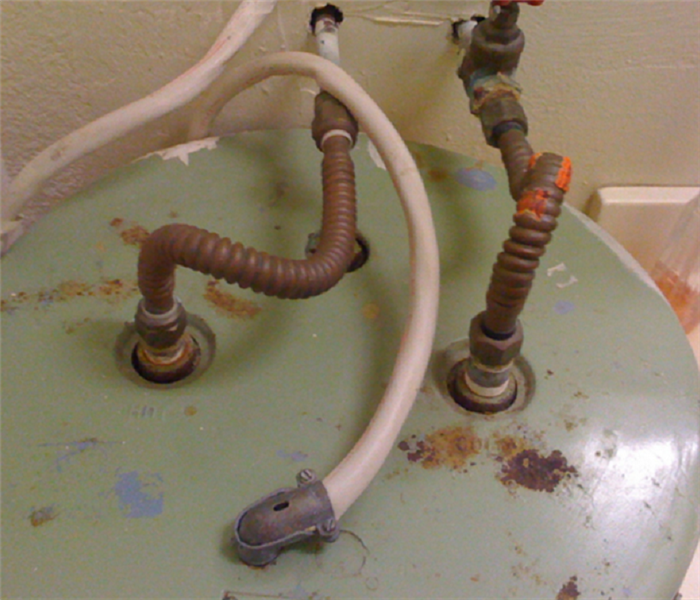 Picture of an old water heater
Picture of an old water heater
Water heaters are essential elements of our home. We use them in daily activities such as taking a bath, using the dishwasher and using the washing machine. But because we use them frequently, it’s sometimes easy to take them for granted and forget that they need to be maintained. Failing to do so will result in malfunctions and problems and eventually, replacing your water heater. Taking notice of the first signs of a problem can help you repair your water heater before it becomes worse.
You don’t have to be an expert to spot the first signs of trouble. All you need to have is a keen sense of observation so that your water heater can be repaired.
Here are three signs that indicate your water heater needs to be repaired.
Hot water has off smell or off color. The first instance that you notice your hot water has an off smell or has a rusty color, that’s something that you need to check out. The smell could be the result of a rusty anode rod in the water heater. There is no need to worry since the anode rod can be replaced that will then eliminate the bad odor. Bacteria growth also causes bad smells. This happens when the hot water has not been used or has been turned off for quite some time or when the thermostat is set at a very low level.
Corroded pipes can also cause an off color in your water. This can be solved by installing a water softener or by replacing the plumbing. If you also see a lot of sediments in the water, it’s time to have the water heater repaired.
Water is not hot enough, too hot, not strong enough or there is none at all. When there is no water, check first that your water heater has power and is working fine. If it is, have it inspected by a plumber. If water is not enough, this could be due to an undersized water heater and is a common situation when a lot more people are using the water heater. This could also be caused by the presence of mineral deposits inside the water heater tank. When water is too hot or not hot enough, you may have to adjust the temperature dial of the water heater. If there is no change in temperature, have the water heater checked and repaired.
Strange noises and leaks. Leaks coming from your water heater could lead to flooding. In the same way, strange noises like pops, bangs, gurgles, and the like are clear indicators that something is wrong with your water heater. This is usually caused by a buildup of sediments inside the tank. A boiling sound, however, could mean the water heater is overheating or that pressure is building up inside the tank. All these have to be addressed immediately to prevent further problems.
It’s important to have your water heater repaired as soon as you see these signs. This will help you save on costs, prevent further damage, and avoid an untimely replacement of your unit.
If your hot water heater malfunctions and creates a water damage, please call SERVPRO of Cambridge/Belmont (617) 864-7378 to assist you with the water damage.
Hidden water, is it covered by insurance?
7/2/2018 (Permalink)
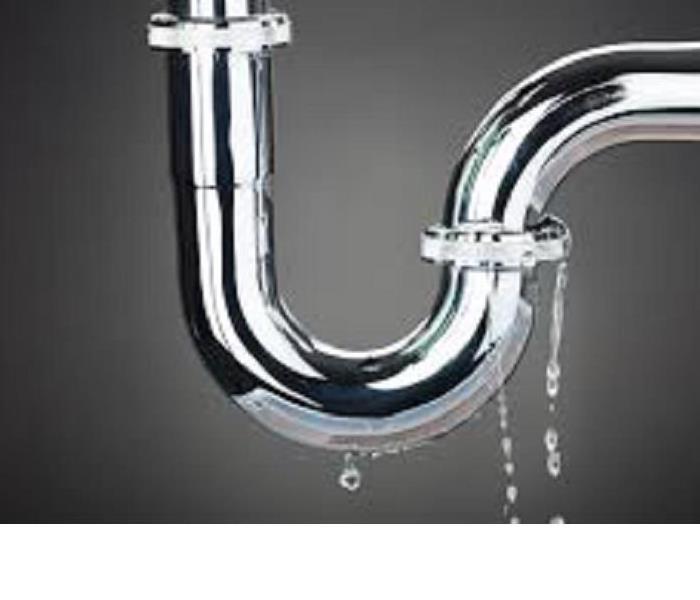 Slow leak under the kitchen sink
Slow leak under the kitchen sink
Whether it's behind the washer, above the ceiling or under the sink, a little drip can lead to big trouble. Water damage happens quickly and can be expensive to fix. Ignore a leak, and you not only could you have a mighty mess on your hands, but your home insurance probably won't bail you out. "What's really important to know for leaks is when did the insured notice it and take action," Says Michael Pridham from SERVPRO of Cambridge/Belmont
"People now build houses to be airtight," says Michael Pridham, owner of SERVPRO of Cambridge/Belmont, a property-damage restoration service. "Houses are wrapped in plastic like Saran Wrap. That's good for energy conservation, but if water gets on the wrong side of that plastic, then mold will follow, as certainly as night follows day." Pridham observes that damage often occurs after people get security systems installed. Holes are drilled into airtight window frames for wires to run through them, but they aren't properly caulked and sealed, allowing water to slowly seep in over time. "You notice that maybe the wall below the window is looking funny, and by that time the framing behind it is rotted out," he says. If the homeowner reports the problem right away, it would likely be covered by home insurance.
But what about a slow leak you can't see? Say, for instance, a pipe behind a wall leaks, and you don't notice it until water starts seeping through the wall. Are you covered? Most likely the answer is yes, as long as you take action as soon as there is evidence of the leak, Pridham says. "Nobody expects you to tear out your drywall now and again to check the pipes. Call the professionals at SERVPRO of Cambridge/Belmont (617) 864-7378. They will send out a crew to test the walls using moisture detectors and an infrared camera.
Insurance companies understand it's impossible to know you have a hidden leak until the damage becomes apparent. The same goes for leaks behind and under appliances, or above a ceiling. If you can't see the leak, you can still make an insurance claim as long as you report it when it becomes apparent. Don't expect much sympathy if you ignore the wet spot in your ceiling, only to report it when the problem gets worse. The insurance adjuster probably will be able to tell if the damage is fresh.
"If the insured had a leak in the roof and had a pot under it for six months, then that damage is not covered," Pridham of SERVPRO of Cambridge/Belmont says. "Insurance Professionals are pretty good at seeing whether a wet spot has been there for a while. Sometimes they have engineers go out to look." When it comes to insurance coverage, everything depends on the language in your policy. Although most policies cover damage from leaks as long as you responded quickly, language among policies differs. Keep in mind, though, that while home insurance may cover the water damage to the ceiling, floor, walls or furniture, it won't pay for replacing the worn-out pipe or the leaky roof (unless the roof was damaged by a covered peril, such as hail or a fallen tree).
Sergio Rodriguez, Production Manager for SERVPRO of Cambridge/Belmont suggests making sure all holes are properly caulked and sealed and keeping eaves and downspouts clean. He recommends periodically checking behind appliances and under sinks to make sure everything is dry. That means actually moving out the stuff that's been sitting under the kitchen sink for the last several years. Be careful when pulling out the refrigerator to check for a leak in the ice maker water line. Avoid running over the water line or crimping a copper line. Rodriguez also suggests replacing rubber supply hoses to appliances with braided hoses, which are made of rubber surrounded by wire mesh. Braided hoses can still spring a leak, but they won't burst.
If you think you have a leak, call the professionals at SERVPRO of Cambridge/Belmont (617) 864-7378
Drying with no demolition
7/2/2018 (Permalink)
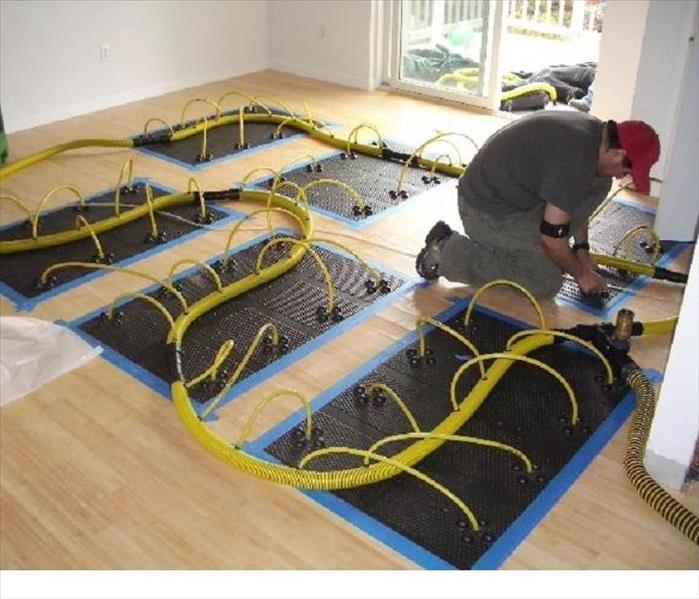 Inject-I-Dry System drying hardwood fllor
Inject-I-Dry System drying hardwood fllor
Peter & Sue Miller’s contractor had finally finished the renovations. They had been living with relatives until their new condominium was finished. The furniture and belongings were delivered and they were finally living in their dream home. They came home Sunday night after a weekend away and they noticed water dripping down from the ceiling. Their hardwood floors had standing water and were beginning to buckle. They discovered that their upstairs neighbor pipe broke causing the water to run down into their unit. They called SERVPRO of Cambridge/Belmont to assist them. The Millers explained that they had just moved in and didn’t want the life to be disrupted. The SERVPRO technician assessed the damages and came up with a plan that would not require any demolition. He discovered there were existing cavities he could install an Inject-I-Dry System that would dry out the floors & ceilings without any demolition or sanding. The technician monitored the drying progress and after one week, he determined that the floor and ceiling were dry and removed the equipment. The Miller’s were ecstatic!
If you sustain water damage, please call SERVPRO of Cambridge/Belmont (617) 864-7378 to assist you.
Hidden water leaks
6/7/2018 (Permalink)
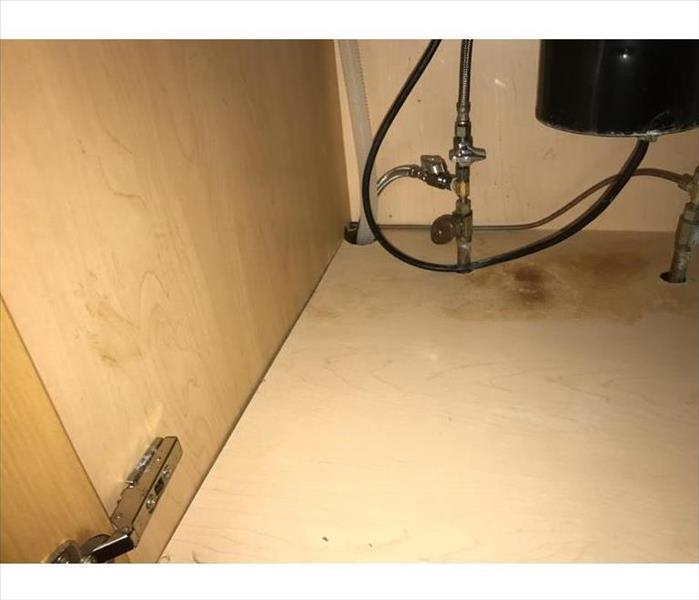 Hidden water leak
Hidden water leak
Whether it's behind the washer, above the ceiling or under the sink, a little drip can lead to big trouble. Water damage happens quickly and can be expensive to fix. Ignore a leak, and you not only could you have a mighty mess on your hands, but your home insurance probably won't bail you out. "What's really important to know for leaks is when did the insured notice it and take action," Says Michael Pridham from SERVPRO of Cambridge/Belmont
"People now build houses to be airtight," says Michael Pridham, owner of SERVPRO of Cambridge/Belmont, a property-damage restoration service. "Houses are wrapped in plastic like Saran Wrap. That's good for energy conservation, but if water gets on the wrong side of that plastic, then mold will follow, as certainly as night follows day." Pridham observes that damage often occurs after people get security systems installed. Holes are drilled into airtight window frames for wires to run through them, but they aren't properly caulked and sealed, allowing water to slowly seep in over time. "You notice that maybe the wall below the window is looking funny, and by that time the framing behind it is rotted out," he says. If the homeowner reports the problem right away, it would likely be covered by home insurance.
Today's houses also have more bathrooms, and the washing machine is often located next to the master bedroom on an upper floor for convenience, Pridham notes. "That means you've got more pipes, and if the washing machine leaks, it can affect the third floor, the second floor, the first floor and even down to the basement," he says. For water damage from leaky appliances or pipes, the damage must be "sudden and accidental" in order to be covered by insurance - such as a pipe that bursts while you're washing clothes.
But what about a slow leak you can't see? Say, for instance, a pipe behind a wall leaks, and you don't notice it until water starts seeping through the wall. Are you covered? Most likely the answer is yes, as long as you take action as soon as there is evidence of the leak, Pridham says. "Nobody expects you to tear out your drywall now and again to check the pipes. Call the professionals at SERVPRO of Cambridge/Belmont (617) 864-7378. They will send out a crew to test the walls using moisture detectors and an infrared camera.
Insurance companies understand it's impossible to know you have a hidden leak until the damage becomes apparent. The same goes for leaks behind and under appliances, or above a ceiling. If you can't see the leak, you can still make an insurance claim as long as you report it when it becomes apparent. Don't expect much sympathy if you ignore the wet spot in your ceiling, only to report it when the problem gets worse. The insurance adjuster probably will be able to tell if the damage is fresh.
"If the insured had a leak in the roof and had a pot under it for six months, then that damage is not covered," Pridham of SERVPRO of Cambridge/Belmont says. "Insurance Professionals are pretty good at seeing whether a wet spot has been there for a while. Sometimes they have engineers go out to look." When it comes to insurance coverage, everything depends on the language in your policy. Although most policies cover damage from leaks as long as you responded quickly, language among policies differs. Keep in mind, though, that while home insurance may cover the water damage to the ceiling, floor, walls or furniture, it won't pay for replacing the worn-out pipe or the leaky roof (unless the roof was damaged by a covered peril, such as hail or a fallen tree).
Sergio Rodriguez, Production Manager for SERVPRO of Cambridge/Belmont suggests making sure all holes are properly caulked and sealed and keeping eaves and downspouts clean. He recommends periodically checking behind appliances and under sinks to make sure everything is dry. That means actually moving out the stuff that's been sitting under the kitchen sink for the last several years. Be careful when pulling out the refrigerator to check for a leak in the ice maker water line. Avoid running over the water line or crimping a copper line. Rodriguez also suggests replacing rubber supply hoses to appliances with braided hoses, which are made of rubber surrounded by wire mesh. Braided hoses can still spring a leak, but they won't burst.
If you think you have a leak, call the professionals at SERVPRO of Cambridge/Belmont (617) 864-7378
The most common plumbing issues
6/7/2018 (Permalink)
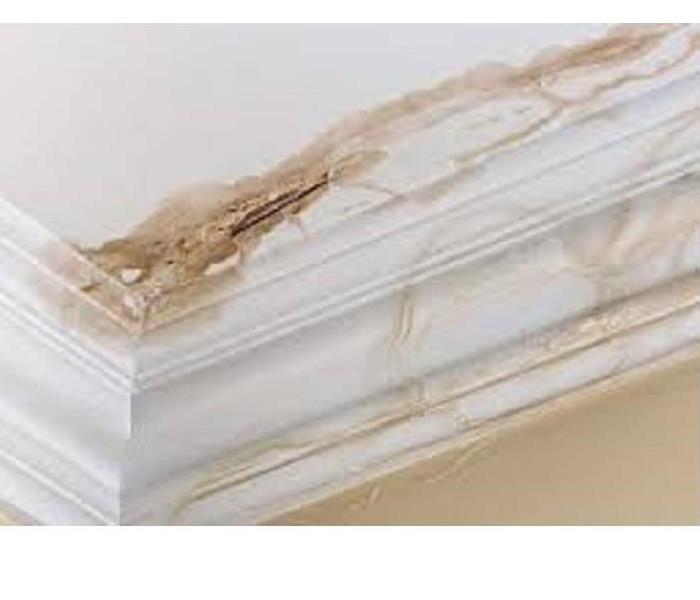 Water damage to ceiling
Water damage to ceiling
You depend on your plumbing each and every day, from the hot water in your shower to the water boiling on your stove. As such, it’s important to maintain your plumbing regularly to make sure there aren’t any major issues such as leaks or sewage backups. But plumbing problems can still occur with regular maintenance, so it’s good to be aware of common plumbing issues and what you can do to solve them or minimize damage to your home.
Low Water Pressure
Proper water pressure is necessary for washing your hands, cleaning dishes, and taking a shower. If you’ve noticed a significant drop in your home’s water pressure, you probably have a clogged pipe. It’s also possible that you need to fully open your shutoff valve. If you’re only having water pressure issues with one faucet, the solution may be as simple as cleaning the aerator or removing a nearby clog.
Dripping Faucet
Depending on the severity of the drip, a dripping faucet can raise your water bill and waste a significant amount of water—not to mention how annoying it can be. Luckily, fixing a dripping faucet is usually as simple as replacing seats and springs or a washer in the faucet.
Running Toilet
It happens so frequently: minutes after flushing your toilet, you can still hear the toilet running as if the bowl is filling with water. This is an incredibly annoying problem to have, but usually, an easy one to fix. Remove the lid from your toilet tank and make sure that your tank ball, flapper valve, and flush valve are working properly—if any of them are sticking or not functioning right, they’re easy to replace.
Clogged Drain
Clogged or slow drains are probably the most common plumbing problem. Plumbing pipes are designed to allow water and waste to flow through freely, but over time, built up hair, soap scum and other debris can form a clog in your drain that prevents water from passing. This is almost sure to happen in any home given enough time. You can use vinegar and baking soda to break up clogs in your sink, or you can buy a drain auger and remove the clog manually.
Sometimes the clog may be deeper in your pipes or too severe to easily remove, look into professional plumbing services; they have the equipment and expertise to clear clogged drains without causing damage to your plumbing. If you have sewage damage as a result of a clogged drain or other plumbing issues, please call SERVPRO of Cambridge/Belmont (617) 864-7378
Leaking Pipes
Leaks aren’t just an annoyance; they can significantly increase your water bill and quickly cause damage to your home. If you have a leaking pipe that’s beyond a slow drip, shut your water off as soon as possible. If there is any chance of mold or structural damage to your home, call SERVPRO of Cambridge/Belmont (617) 864-7378 to avoid spending a fortune on repairs. Leaking pipes generally need to be replaced, but you can use marine tape or epoxy to cover small leaks temporarily—just remember to shut the water off first.
No Hot Water
Have you ever rolled out of bed and into the shower only to find there’s no hot water? It’s not a good experience. Chances are you’ve got something wrong with your water heater, most probably an electrical problem such as a thermostat or element. If you’re not comfortable troubleshooting your water heater, it’s a good idea to get help from a trained, knowledgeable professional.
Plumbing truly is an essential part of our everyday lives. We can’t all be professional plumbers, but with a little bit of research and hard work, you can stay cool, calm and collected in the face of a plumbing emergency
If you have water damage as a result of any of these or other plumbing issues, please call SERVPRO of Cambridge/Belmont (617) 864-7378
Preventing water damage
5/9/2018 (Permalink)
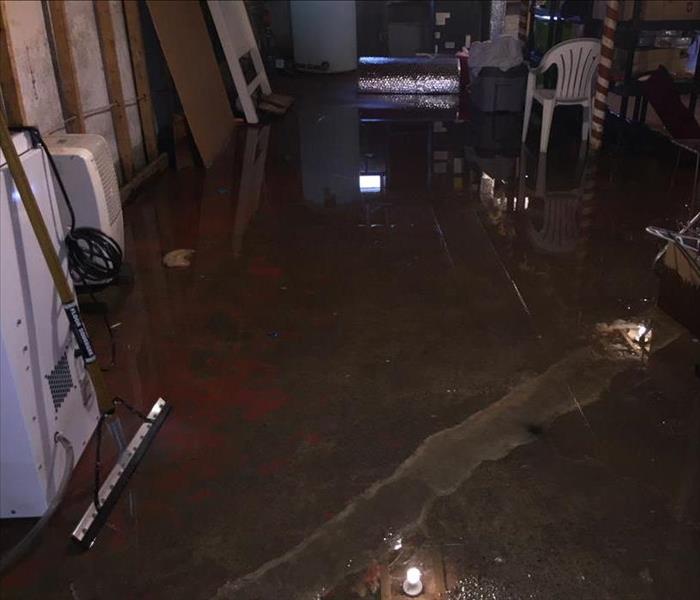 This flooded basement could have been prevented
This flooded basement could have been prevented
Preventing a water disaster in the basement
Sergio Rodriguez, Production Manager for SERVPRO of Cambridge/Belmont suggests making sure all holes are properly caulked and sealed and keeping eaves and downspouts clean. He recommends periodically checking behind appliances and under sinks to make sure everything is dry. That means actually moving out the stuff that's been sitting under the kitchen sink for the last several years. Be careful when pulling out the refrigerator to check for a leak in the ice maker water line. Avoid running over the water line or crimping a copper line. Rodriguez also suggests replacing rubber supply hoses to appliances with braided hoses, which are made of rubber surrounded by wire mesh. Braided hoses can still spring a leak, but they won't burst.
If you think you have a leak, call the professionals at SERVPRO of Cambridge/Belmont (617) 864-7378
Ten tips to help prevent water damage to your home
8/15/2017 (Permalink)
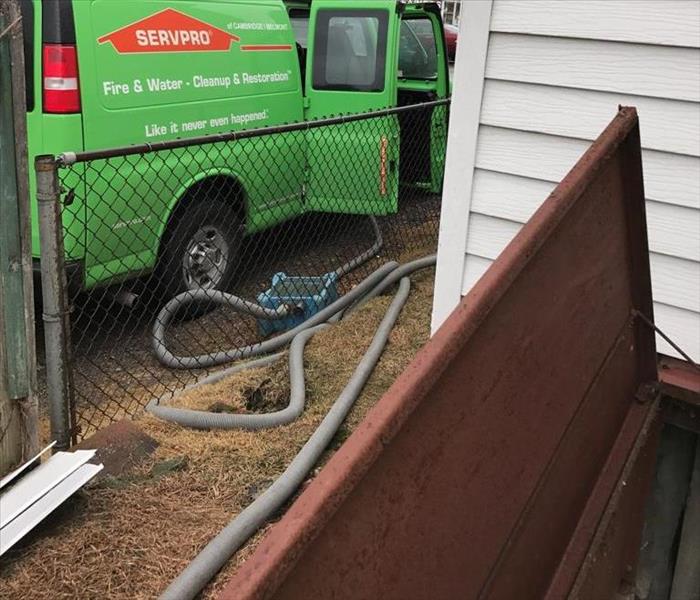 A SERVPRO truck extracting water after a burst pipe.
A SERVPRO truck extracting water after a burst pipe.
- Disconnect hoses
Standing water in a hose may freeze back into the pipe. This may create an ice block that stops your water flow. The block may may burst your pipes and create damage to walls, floor and foundation.
- Clean gutters and downspouts
Clean your gutters at least twice a year to avoid blockage and ice dams. Standing water can cause damage to your gutters and roof, and unmanaged overflow may create puddles that could damage your foundation.
Don't forget to clean downspouts to ensure water can flow through, and secure downspouts so that they point away from the home.
- Maintain trees and vegetation
Thriving shrubs can be a beautiful thing — except when their roots wrap around your pipes and break them. That's why it's important to minimize landscaping near utility pipes or, if necessary, remove trees and shrubs that have become too big.
Interior Measures to Prevent Water Damage
- Know your water main
Know the location of your water main, and shut it off if you leave for an extended amount of time. If no water goes in to the house, chances are no faucet drips can wreak havoc on your home while you're away.
- Check appliances regularly
Check and maintain your home appliances regularly for leaks, according to manufacturer's directions.
- Investigate leaks right away and fix promptly
If you opt to ignore moisture damage or postpone making the necessary repairs, be prepared to experience mold, mildew, dry rot, or even structural damage to your home.
Keep in mind that homeowner's insurance provides coverage for damage that is sudden and accidental. Damage that results from lack of maintenance is not covered on a standard homeowner’s insurance policy.
If it's too late and you're already dealing with a wet disaster, check out advice on how to minimize water damage in your home.
- Upgrade washing machine hoses
Old, brittle or leaky washing machine hoses are among the most frequent causes of water loss for homeowners. Replace yours regularly to avoid a mighty mess and expensive damage.
- Install water detection devices
A water detector is a small electronic device that sounds an alarm when its sensor comes in contact with moisture. Its main benefit is that it detects low moisture levels or slow leaks that often go unnoticed. Install it near water heaters, sump pumps, washing machines, dishwashers and toilets to prevent extensive damage and mold growth.
- Check your water pressure
If the water pressure to your home is set too high, pipes and hoses may fail under the pressure. Buy a water pressure gauge at a local hardware store, attach it to an outside faucet, and turn the faucet to full force. The gauge will give you a reading of the home’s water pressure.
Typical residential water systems are designed for water pressure of 40 to 70 psi. If your home’s water pressure exceeds 100 psi, install a pressure regulator (which is available at hardware stores as well.)
- Monitor your water bill
Sometimes, the only way you know that water is leaking is taking a closer look at your water bill. If your usage jumps significantly from one month to the next without explanation, put your "water detective hat" on. Is there a leak in your crawlspace? Or, is it a pipe in your front yard? Don't leave mystery leaks unattended!
If you have had water damage to your home please call SERVPRO of Cambridge/Belmont (617) 864-7378
Common plumbing problems & how to fix them
6/19/2017 (Permalink)
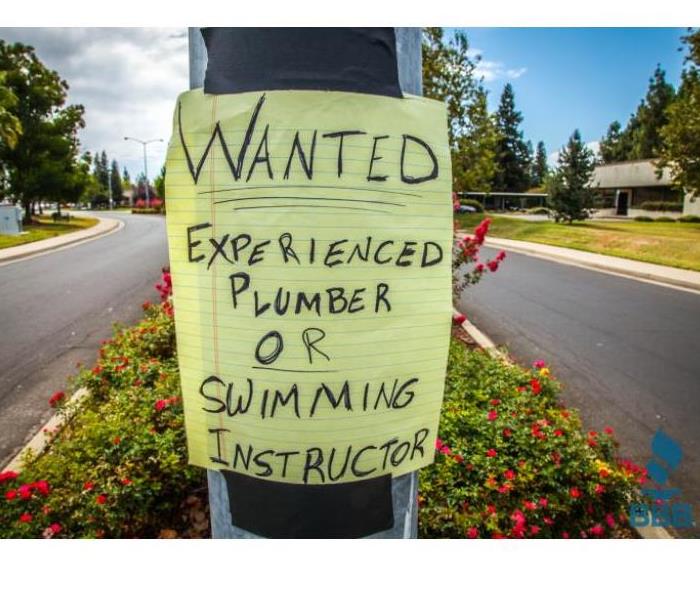 Wanted, experienced plumber
Wanted, experienced plumber
You depend on your plumbing each and every day, from the hot water in your shower to the water boiling on your stove. As such, it’s important to maintain your plumbing regularly to make sure there aren’t any major issues such as leaks or sewage backups. But plumbing problems can still occur with regular maintenance, so it’s good to be aware of common plumbing issues and what you can do to solve them or minimize damage to your home.
Low Water Pressure
Proper water pressure is necessary for washing your hands, cleaning dishes, and taking a shower. If you’ve noticed a significant drop in your home’s water pressure, you probably have a clogged pipe. It’s also possible that you need to fully open your shutoff valve. If you’re only having water pressure issues with one faucet, the solution may be as simple as cleaning the aerator or removing a nearby clog.
Dripping Faucet
Depending on the severity of the drip, a dripping faucet can raise your water bill and waste a significant amount of water—not to mention how annoying it can be. Luckily, fixing a dripping faucet is usually as simple as replacing seats and springs or a washer in the faucet.
Running Toilet
It happens so frequently: minutes after flushing your toilet, you can still hear the toilet running as if the bowl is filling with water. This is an incredibly annoying problem to have, but usually, an easy one to fix. Remove the lid from your toilet tank and make sure that your tank ball, flapper valve, and flush valve are working properly—if any of them are sticking or not functioning right, they’re easy to replace.
Clogged Drain
Clogged or slow drains are probably the most common plumbing problem. Plumbing pipes are designed to allow water and waste to flow through freely, but over time, built up hair, soap scum and other debris can form a clog in your drain that prevents water from passing. This is almost sure to happen in any home given enough time. You can use vinegar and baking soda to break up clogs in your sink, or you can buy a drain auger and remove the clog manually.
Sometimes the clog may be deeper in your pipes or too severe to easily remove, look into professional plumbing services; they have the equipment and expertise to clear clogged drains without causing damage to your plumbing. If you have sewage damage as a result of a clogged drain or other plumbing issues, please call SERVPRO of Cambridge/Belmont (617) 864-7378
Leaking Pipes
Leaks aren’t just an annoyance; they can significantly increase your water bill and quickly cause damage to your home. If you have a leaking pipe that’s beyond a slow drip, shut your water off as soon as possible. If there is any chance of mold or structural damage to your home, call SERVPRO of Cambridge/Belmont (617) 864-7378 to avoid spending a fortune on repairs. Leaking pipes generally need to be replaced, but you can use marine tape or epoxy to cover small leaks temporarily—just remember to shut the water off first.
No Hot Water
Have you ever rolled out of bed and into the shower only to find there’s no hot water? It’s not a good experience. Chances are you’ve got something wrong with your water heater, most probably an electrical problem such as a thermostat or element. If you’re not comfortable troubleshooting your water heater, it’s a good idea to get help from a trained, knowledgeable professional.
Plumbing truly is an essential part of our everyday lives. We can’t all be professional plumbers, but with a little bit of research and hard work, you can stay cool, calm and collected in the face of a plumbing emergency
If you have water damage as a result of any of these or other plumbing issues, please call SERVPRO of Cambridge/Belmont (617) 864-7378
Water damage from hidden pipe leaks
6/8/2017 (Permalink)
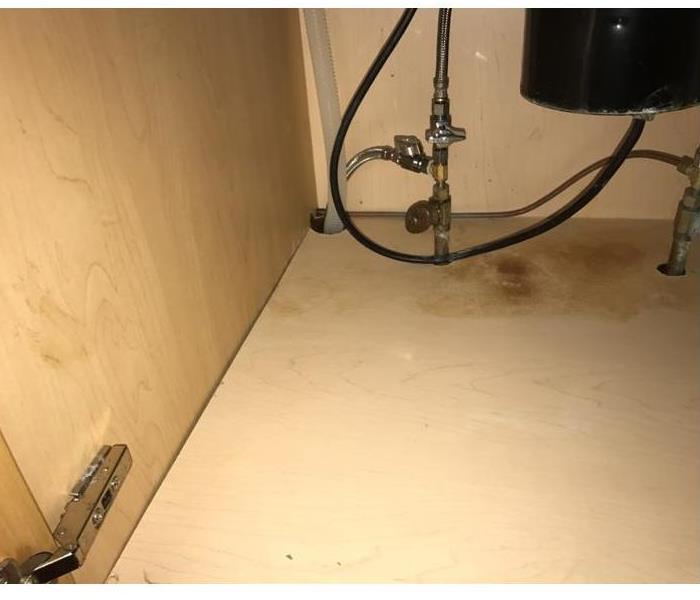 Hidden Pipe leak under kitchen sink.
Hidden Pipe leak under kitchen sink.
Whether it's behind the washer, above the ceiling or under the sink, a little drip can lead to big trouble. Water damage happens quickly and can be expensive to fix. Ignore a leak, and you not only could you have a mighty mess on your hands, but your home insurance probably won't bail you out. "What's really important to know for leaks is when did the insured notice it and take action," Says Michael Pridham from SERVPRO of Cambridge/Belmont
"People now build houses to be airtight," says Michael Pridham, owner of SERVPRO of Cambridge/Belmont, a property-damage restoration service. "Houses are wrapped in plastic like Saran Wrap. That's good for energy conservation, but if water gets on the wrong side of that plastic, then mold will follow, as certainly as night follows day." Pridham observes that damage often occurs after people get security systems installed. Holes are drilled into airtight window frames for wires to run through them, but they aren't properly caulked and sealed, allowing water to slowly seep in over time. "You notice that maybe the wall below the window is looking funny, and by that time the framing behind it is rotted out," he says. If the homeowner reports the problem right away, it would likely be covered by home insurance.
Today's houses also have more bathrooms, and the washing machine is often located next to the master bedroom on an upper floor for convenience, Pridham notes. "That means you've got more pipes, and if the washing machine leaks, it can affect the third floor, the second floor, the first floor and even down to the basement," he says. For water damage from leaky appliances or pipes, the damage must be "sudden and accidental" in order to be covered by insurance - such as a pipe that bursts while you're washing clothes.
But what about a slow leak you can't see? Say, for instance, a pipe behind a wall leaks, and you don't notice it until water starts seeping through the wall. Are you covered? Most likely the answer is yes, as long as you take action as soon as there is evidence of the leak, Pridham says. "Nobody expects you to tear out your drywall now and again to check the pipes. Call the professionals at SERVPRO of Cambridge/Belmont (617) 864-7378. They will send out a crew to test the walls using moisture detectors and an infrared camera.
Insurance companies understand it's impossible to know you have a hidden leak until the damage becomes apparent. The same goes for leaks behind and under appliances, or above a ceiling. If you can't see the leak, you can still make an insurance claim as long as you report it when it becomes apparent. Don't expect much sympathy if you ignore the wet spot in your ceiling, only to report it when the problem gets worse. The insurance adjuster probably will be able to tell if the damage is fresh.
"If the insured had a leak in the roof and had a pot under it for six months, then that damage is not covered," Pridham of SERVPRO of Cambridge/Belmont says. "Insurance Professionals are pretty good at seeing whether a wet spot has been there for a while. Sometimes they have engineers go out to look." When it comes to insurance coverage, everything depends on the language in your policy. Although most policies cover damage from leaks as long as you responded quickly, language among policies differs. Keep in mind, though, that while home insurance may cover the water damage to the ceiling, floor, walls or furniture, it won't pay for replacing the worn-out pipe or the leaky roof (unless the roof was damaged by a covered peril, such as hail or a fallen tree).
Sergio Rodriguez, Production Manager for SERVPRO of Cambridge/Belmont suggests making sure all holes are properly caulked and sealed and keeping eaves and downspouts clean. He recommends periodically checking behind appliances and under sinks to make sure everything is dry. That means actually moving out the stuff that's been sitting under the kitchen sink for the last several years. Be careful when pulling out the refrigerator to check for a leak in the ice maker water line. Avoid running over the water line or crimping a copper line. Rodriguez also suggests replacing rubber supply hoses to appliances with braided hoses, which are made of rubber surrounded by wire mesh. Braided hoses can still spring a leak, but they won't burst.
If you think you have a leak, call the professionals at SERVPRO of Cambridge/Belmont (617) 864-7378
Leaky Dishwasher
6/2/2017 (Permalink)
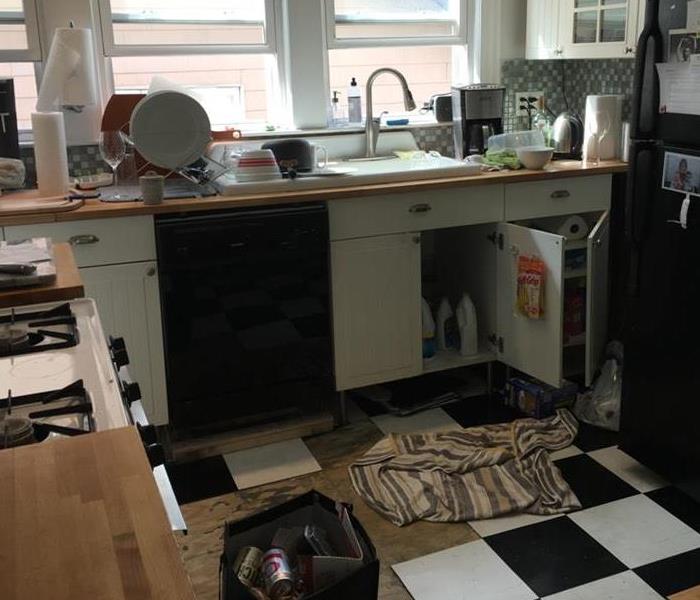 Water damage from a malfunctioning Dishwasher
Water damage from a malfunctioning Dishwasher
Has your dishwasher stopped draining? Did you accidentally break the sliding rack? Have the buttons just stopped working? You need a repair pro. We asked Michael Pridham of SERVPRO of Cambridge/Belmont and Craig Kimble of We Can Fix That to share their best tips for when to repair an ailing dishwasher, when to replace it and what to do if it begins to leak water.
When to Fix: Common Dishwasher Issues
Typical dishwasher problems involve broken mechanical parts, says Craig of We Can Fix That. Think a broken soap dispenser, dislodged sliding rack wheel, or broken sprayer arm.
When a dishwasher won’t drain, there’s usually something in the drain process that shouldn’t be there like lemon seeds, glass, plastic wrap or even bobby pins. “With a high-end dishwasher, you’ll get an OE overflow code. Often I can disconnect the machine, lean it forward, and drain it for a fix without having to replace any of the control boards,” says Craig.
In general, if you have to fix an issue but the unit is relatively new, it makes sense to fix if repair costs are under half the cost to replace the appliance. A good unit can last you 15-20 years if it’s well-maintained.
When to Replace: Do the Math
Once you start to replace the electronic boards, it gets expensive. On high-end dishwashers (KitchenAid, Samsung, Bosch) if the user control panel and the power control unit go out at the same time, it’s not worth it to repair it. “The parts alone will exceed $600 wholesale,” says Craig.
If a dishwasher is more than 7-10 years old and you’re paying more than half of the original cost in repairs, you should consider buying a new one.
Replacing a door latch can get pricey, says Deondre of Lee Appliance Repair and Installation. “This can run $200-250 for parts and labor,” he says, “And you can easily avoid this repair. If you want to add in dishes, don’t just pull it open. Hit pause and let the automatic lock release. It will save you money!”
Leaking is a big problem around the door or underneath where the motor or pumps assembly are, says Deondre. Costs vary depending on how old the unit is or if the control board is gone. For standard dishwashers repairs range from $100-200. For bigger projects or work on higher-end dishwashers (with more expensive parts) average costs might be $380-450.
How to Avoid Issues
Don’t overload it, says Deondre of Lee Appliance Repair and Installation, and when you first have a problem, look at your model number and do some online research to learn about your machine. There might be an easy DIY fix for your symptoms.
Don’t run a garbage disposal at the same time the dishwasher is running, urges Michael of SERVPRO of Cambridge/Belmont. The two share the same plumbing, so if they’re going at the same time, you are more apt to kick debris into the dishwasher discharge line and clog it.
A little preventative maintenance goes a long way. Have a pro come every two years, clean out your lines and any calcium deposits, and get you running clean again. If the dishwasher does leak, call the preferred professional, SERVPRO of Cambridge/Belmont (617) 864-7378.
Hot Water Heater Replacement
5/31/2017 (Permalink)
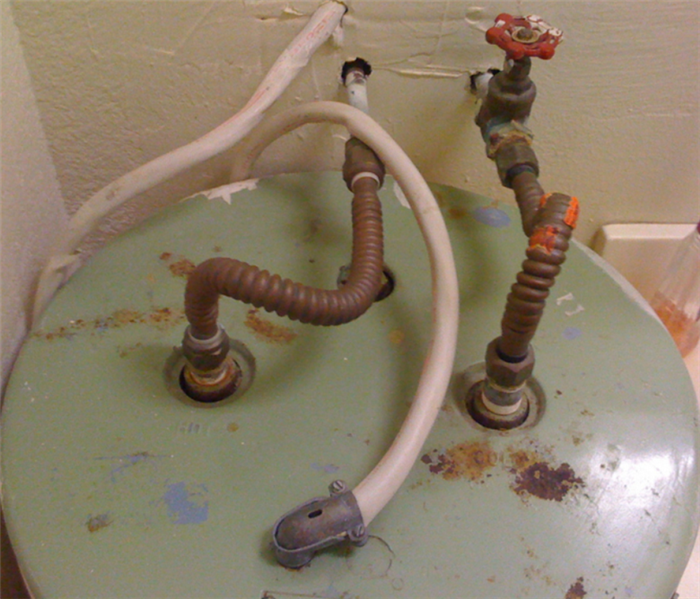 Old Hot Water Heater
Old Hot Water Heater
Water heaters are essential elements of our home. We use them in daily activities such as taking a bath, using the dishwasher and using the washing machine. But because we use them frequently, it’s sometimes easy to take them for granted and forget that they need to be maintained. Failing to do so will result in malfunctions and problems and eventually, replacing your water heater. Taking notice of the first signs of a problem can help you repair your water heater before it becomes worse.
You don’t have to be an expert to spot the first signs of trouble. All you need to have is a keen sense of observation so that your water heater can be repaired.
Here are three signs that indicate your water heater needs to be repaired.
Hot water has off smell or off color. The first instance that you notice your hot water has an off smell or has a rusty color, that’s something that you need to check out. The smell could be the result of a rusty anode rod in the water heater. There is no need to worry since the anode rod can be replaced that will then eliminate the bad odor. Bacteria growth also causes bad smells. This happens when the hot water has not been used or has been turned off for quite some time or when the thermostat is set at a very low level.
Corroded pipes can also cause an off color in your water. This can be solved by installing a water softener or by replacing the plumbing. If you also see a lot of sediments in the water, it’s time to have the water heater repaired.
Water is not hot enough, too hot, not strong enough or there is none at all. When there is no water, check first that your water heater has power and is working fine. If it is, have it inspected by a plumber. If water is not enough, this could be due to an undersized water heater and is a common situation when a lot more people are using the water heater. This could also be caused by the presence of mineral deposits inside the water heater tank. When water is too hot or not hot enough, you may have to adjust the temperature dial of the water heater. If there is no change in temperature, have the water heater checked and repaired.
Strange noises and leaks. Leaks coming from your water heater could lead to flooding. In the same way, strange noises like pops, bangs, gurgles, and the like are clear indicators that something is wrong with your water heater. This is usually caused by a buildup of sediments inside the tank. A boiling sound, however, could mean the water heater is overheating or that pressure is building up inside the tank. All these have to be addressed immediately to prevent further problems.
It’s important to have your water heater repaired as soon as you see these signs. This will help you save on costs, prevent further damage, and avoid an untimely replacement of your unit.
If your hot water heater malfunctions and creates a water damage, please call SERVPRO of Cambridge/Belmont (617) 864-7378 to assist you with the water damage.
Flooded Basements
4/11/2017 (Permalink)
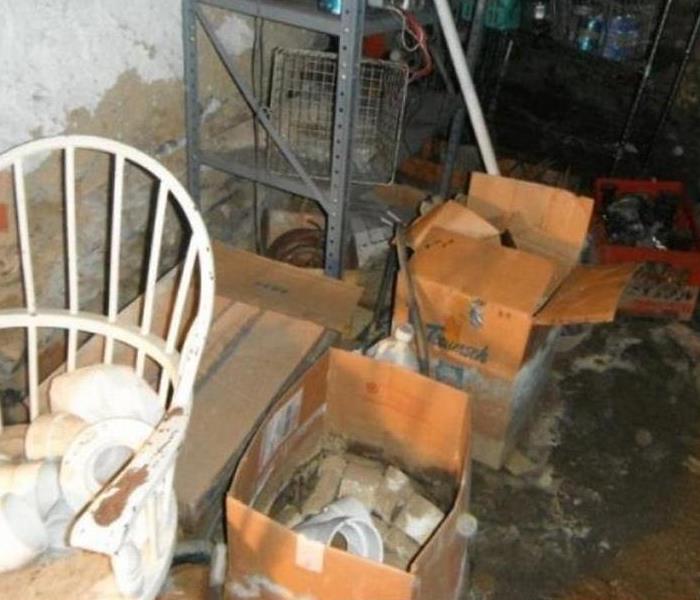 SERVPRO of Cambridge/Belmont provides 24 hour fire and water damage restoration service in Cambridge
SERVPRO of Cambridge/Belmont provides 24 hour fire and water damage restoration service in Cambridge
City of Cambridge 24 Hour Emergency Water Damage Service
SERVPRO of Cambridge/Belmont is available 24 hours a day for water emergencies, large or small. When you are dealing with water damage, immediate action is crucial. A delay of just a few hours can greatly increase the severity of the water damage.
We Answer the Phone Ready to Help
Call Today - (617) 864-7378
We understand that when you call us, you may be feeling confused, stressed, and vulnerable. You need an expert to guide you through this crisis. SERVPRO of Cambridge/Belmont has the specific water damage training and experience to help you through this tough time. We specialize in water damage restoration—in fact, it's the cornerstone of our business.
What to Expect
When you call, we will ask several questions regarding your water damage emergency. These questions will help us determine what equipment and resources to bring, including how many trained SERVPRO Professionals may be needed.
Our SERVPRO Representative will ask several questions:
- Your name and contact information
- Your insurance information (if applicable)
- The street address of the water-damaged home or business
- When did the flooding or water damage occur?
- What caused the water damage (if known)?
- Is there electricity available (on-site)?
About SERVPRO of Cambridge/Belmont
SERVPRO of Cambridge/Belmont specializes in the cleanup and restoration of residential and commercial property after a fire, smoke or water damage event. Our staff is highly trained in property damage restoration. From initial and ongoing training at SERVPRO’s corporate training facility to regular IICRC-industry certification, rest assured our staff is equipped with the knowledge to restore your property.






 24/7 Emergency Service
24/7 Emergency Service







































